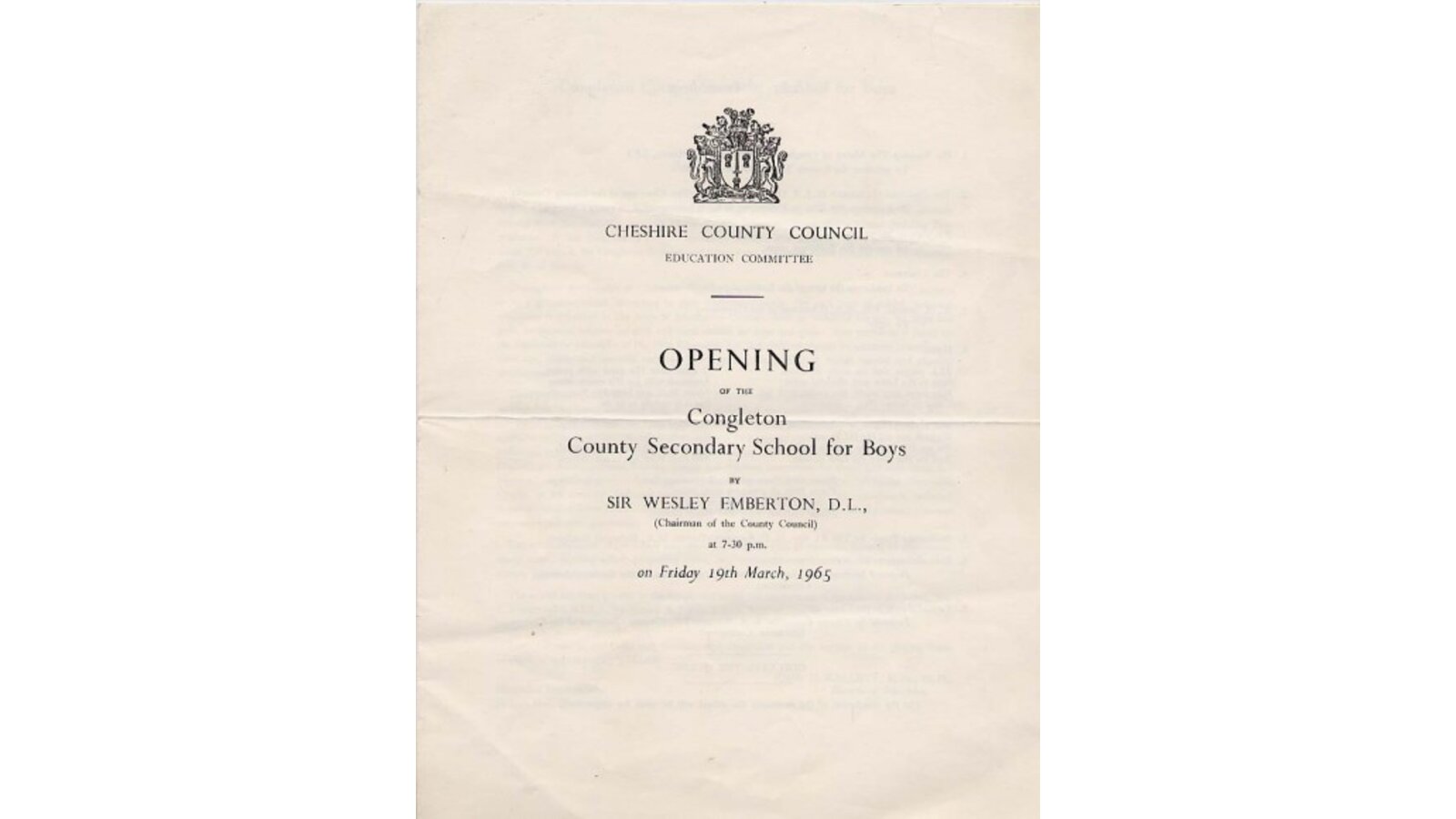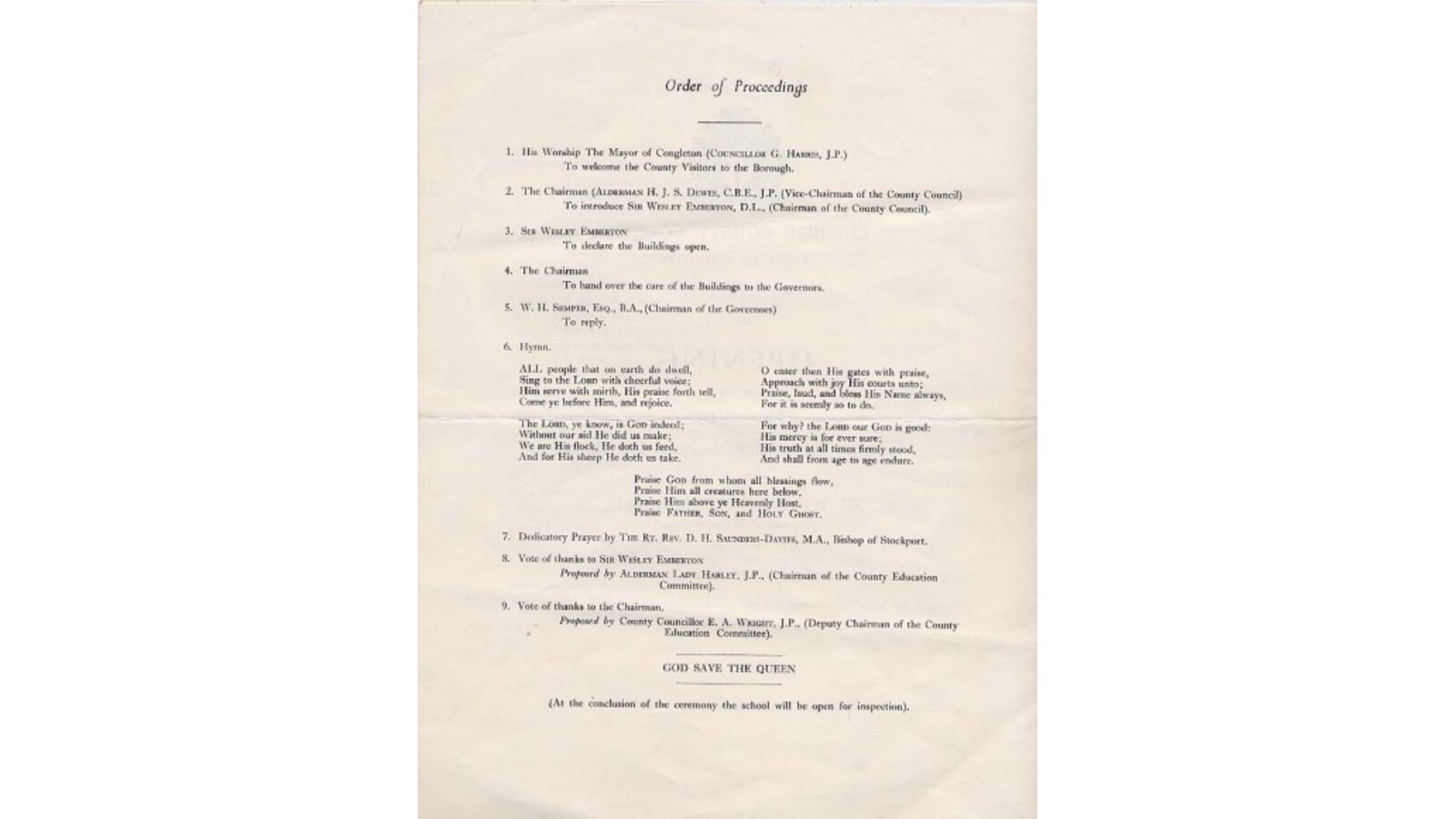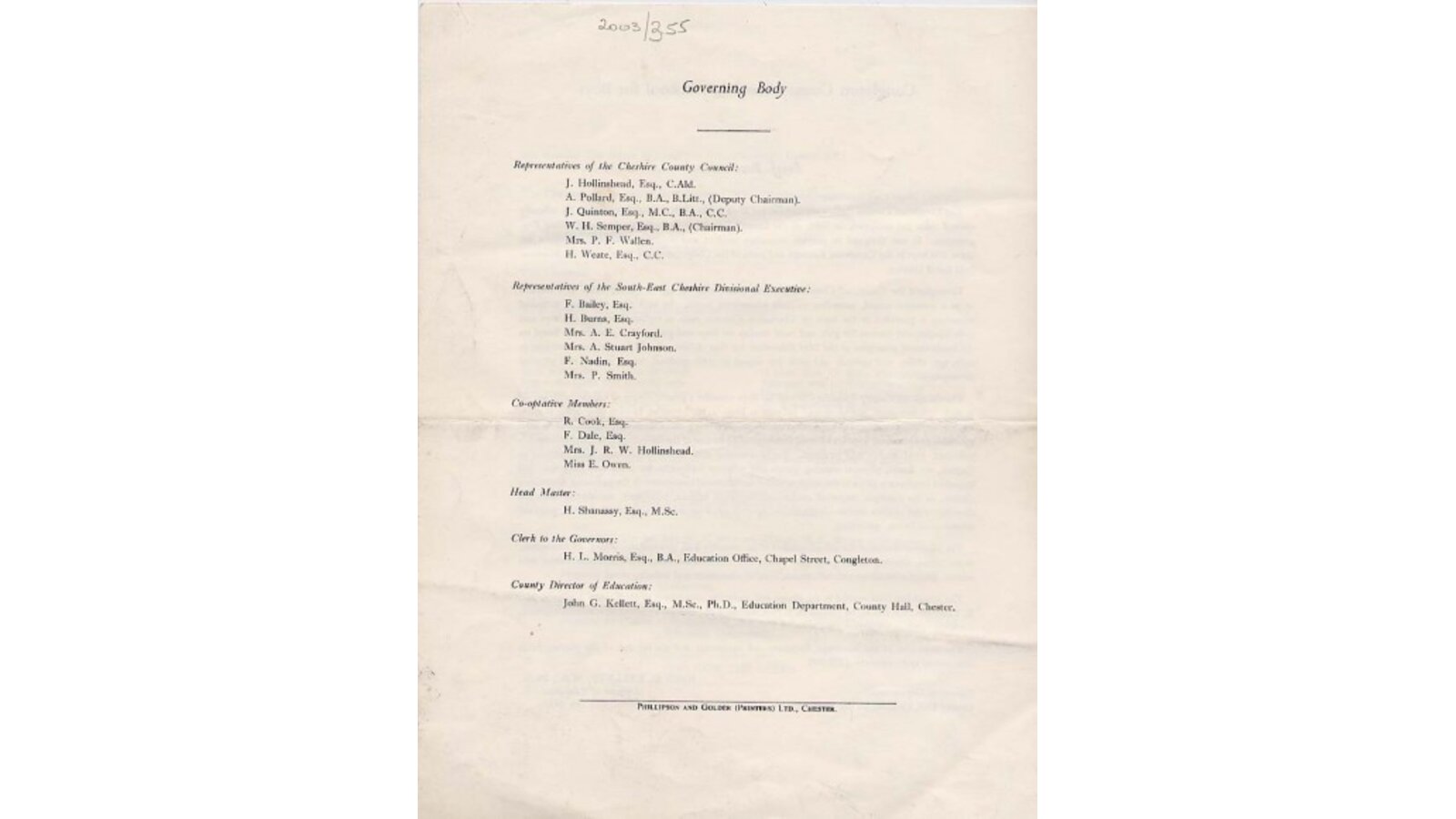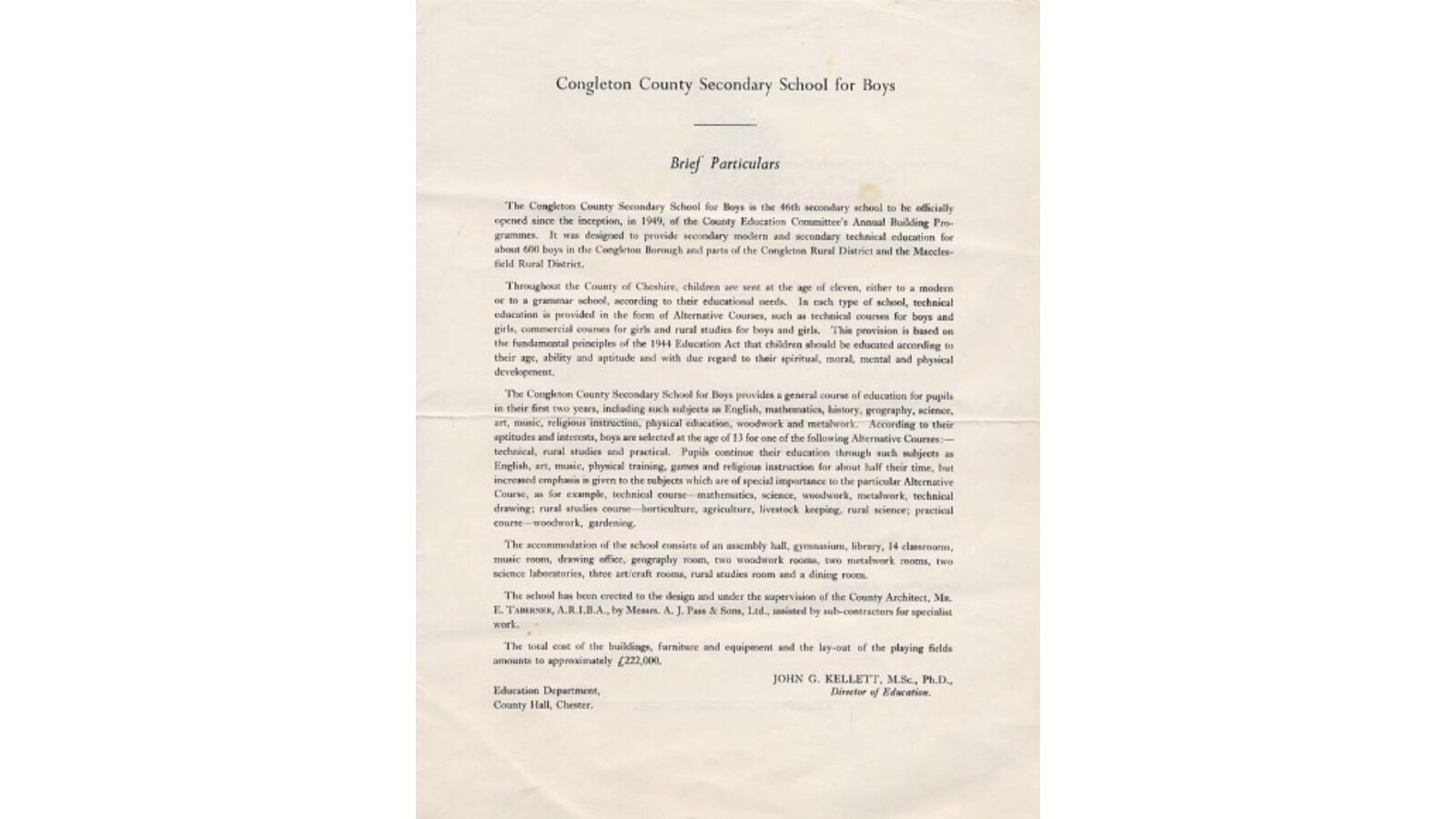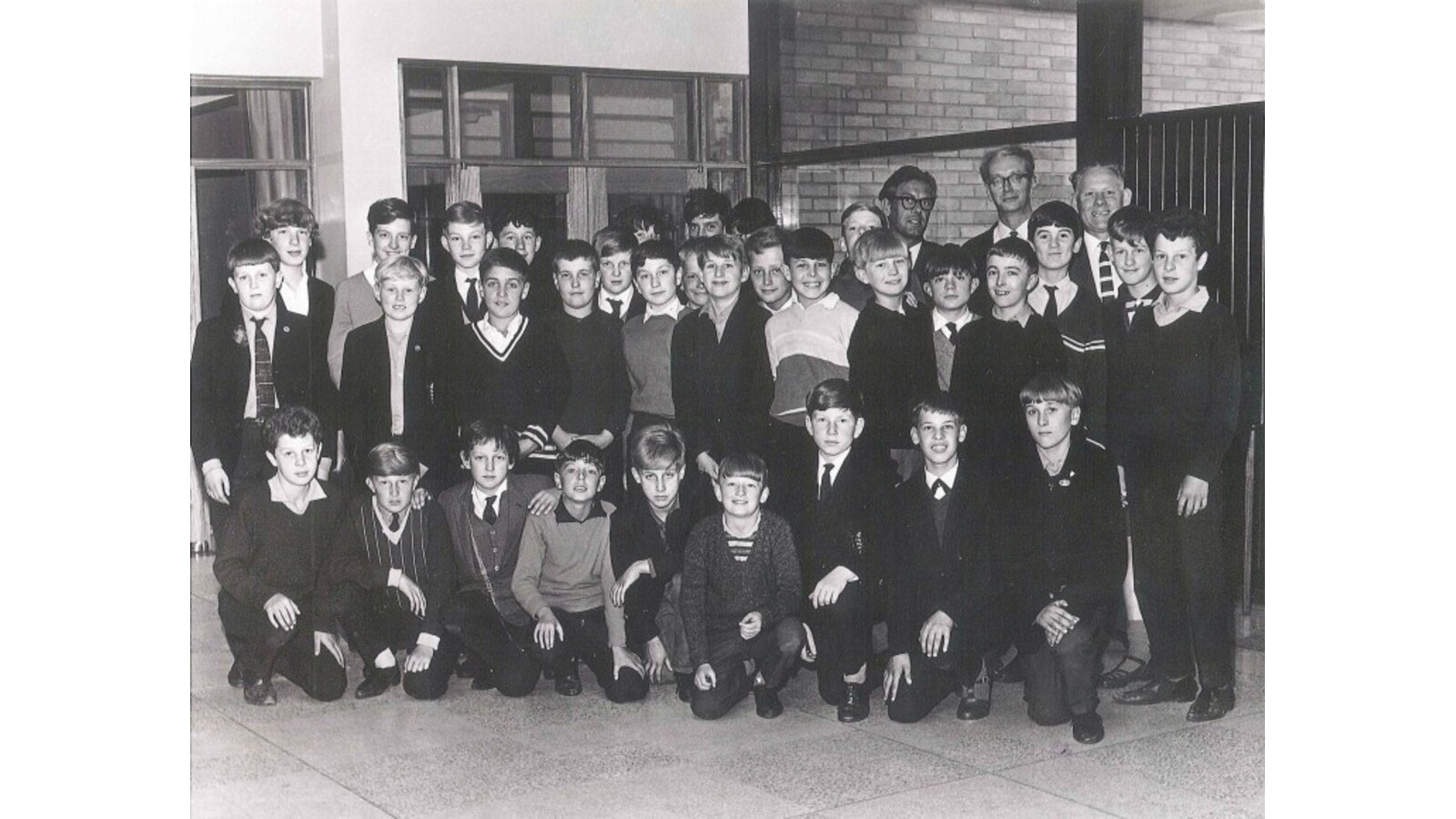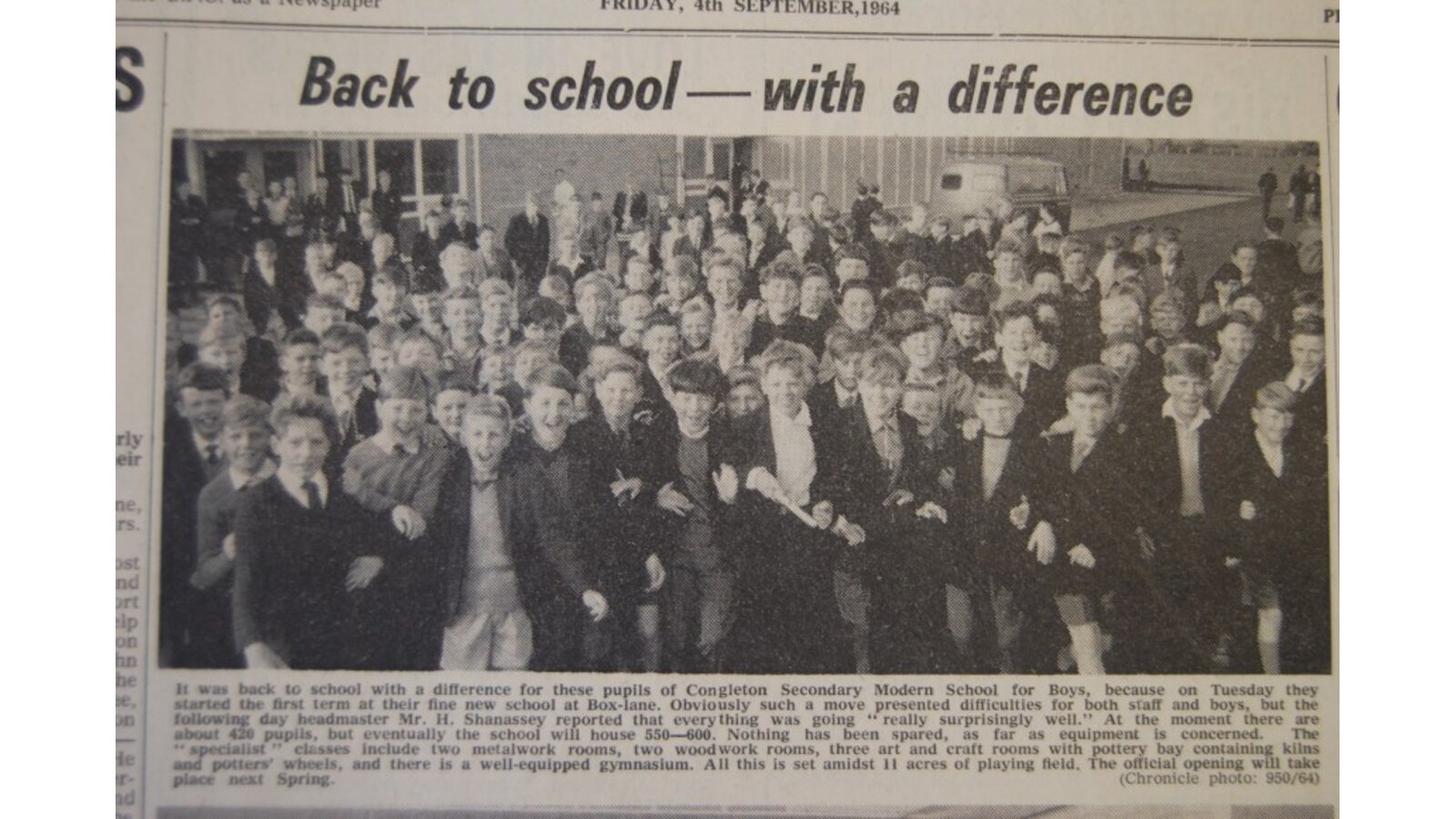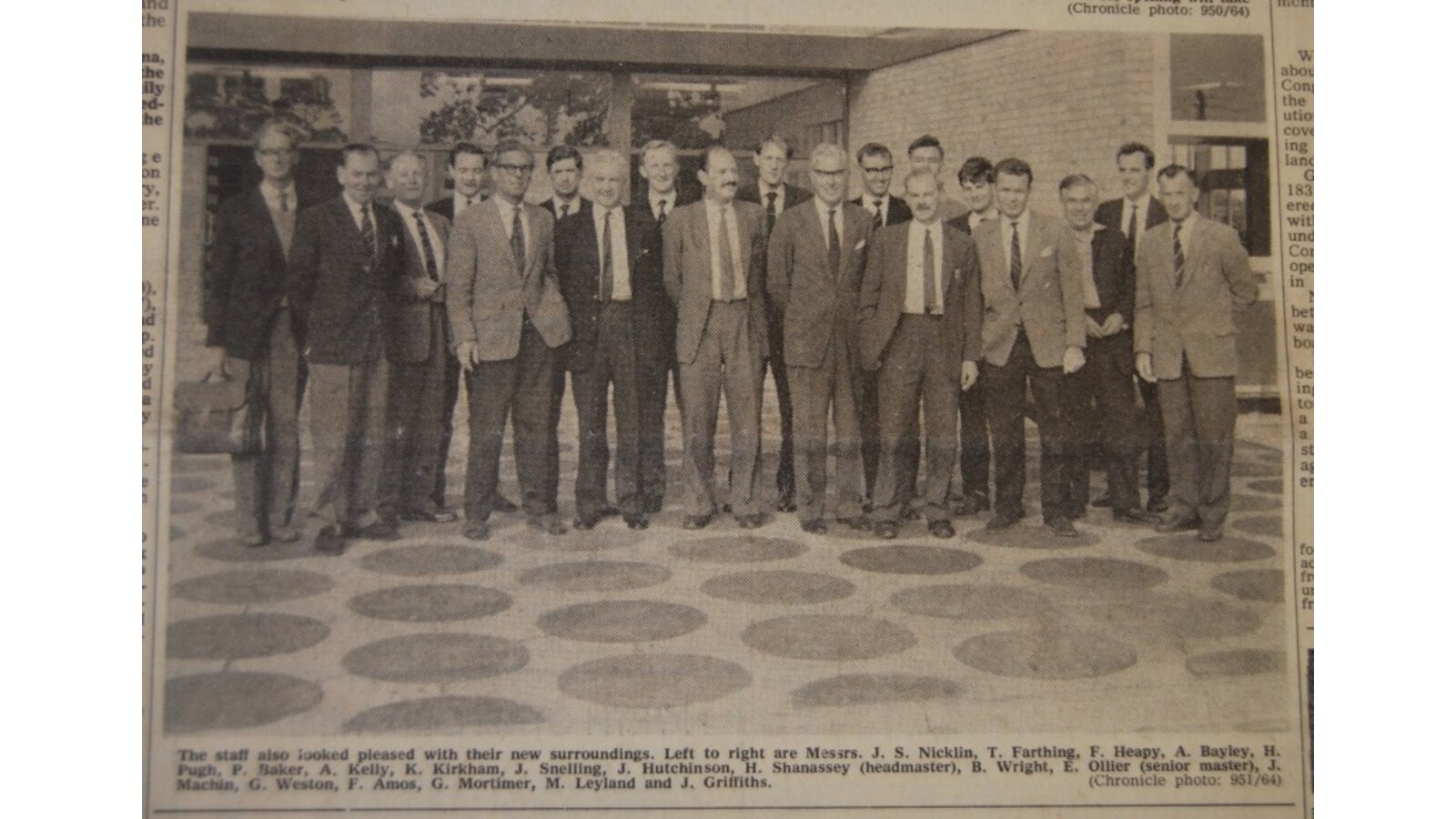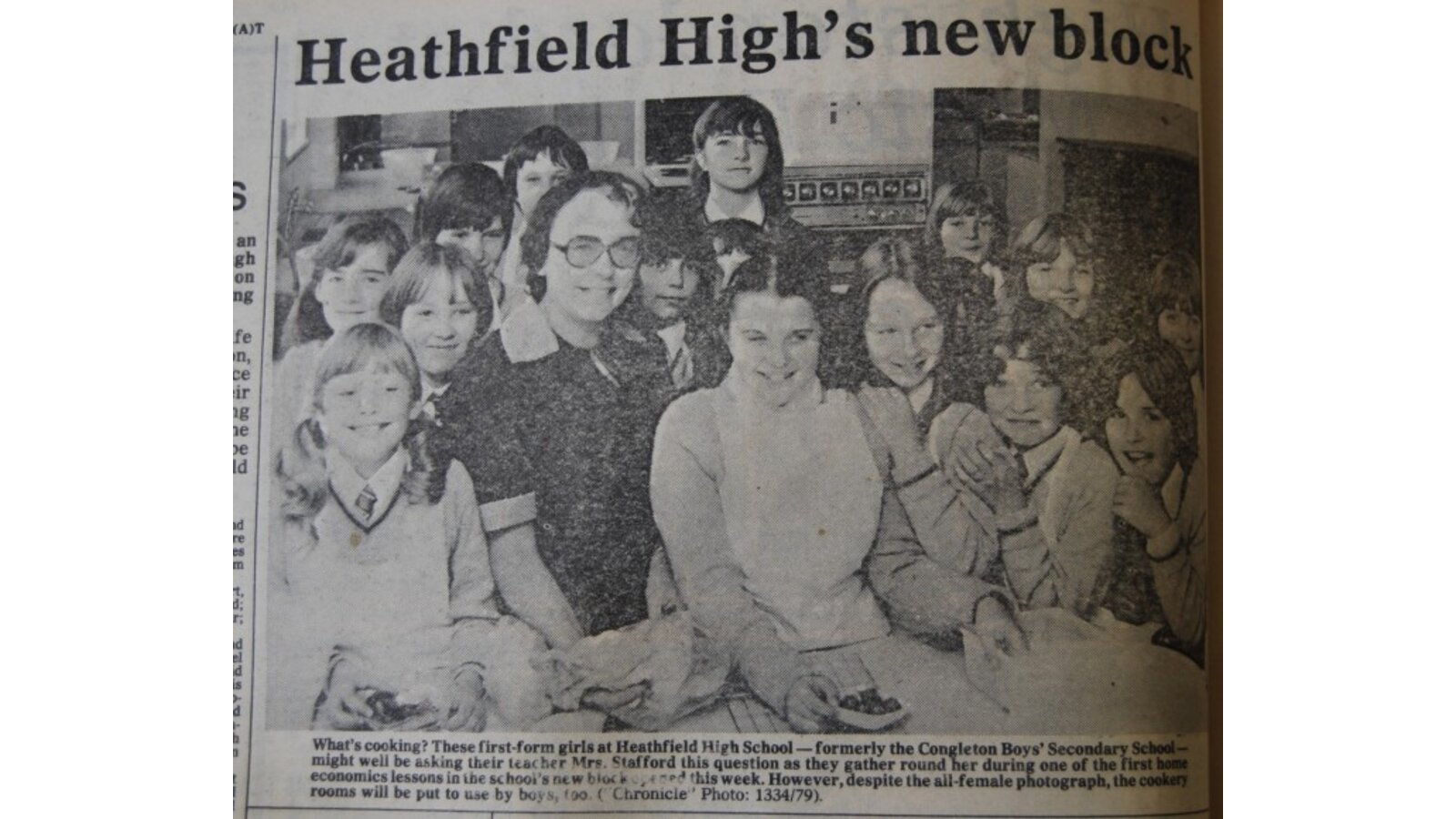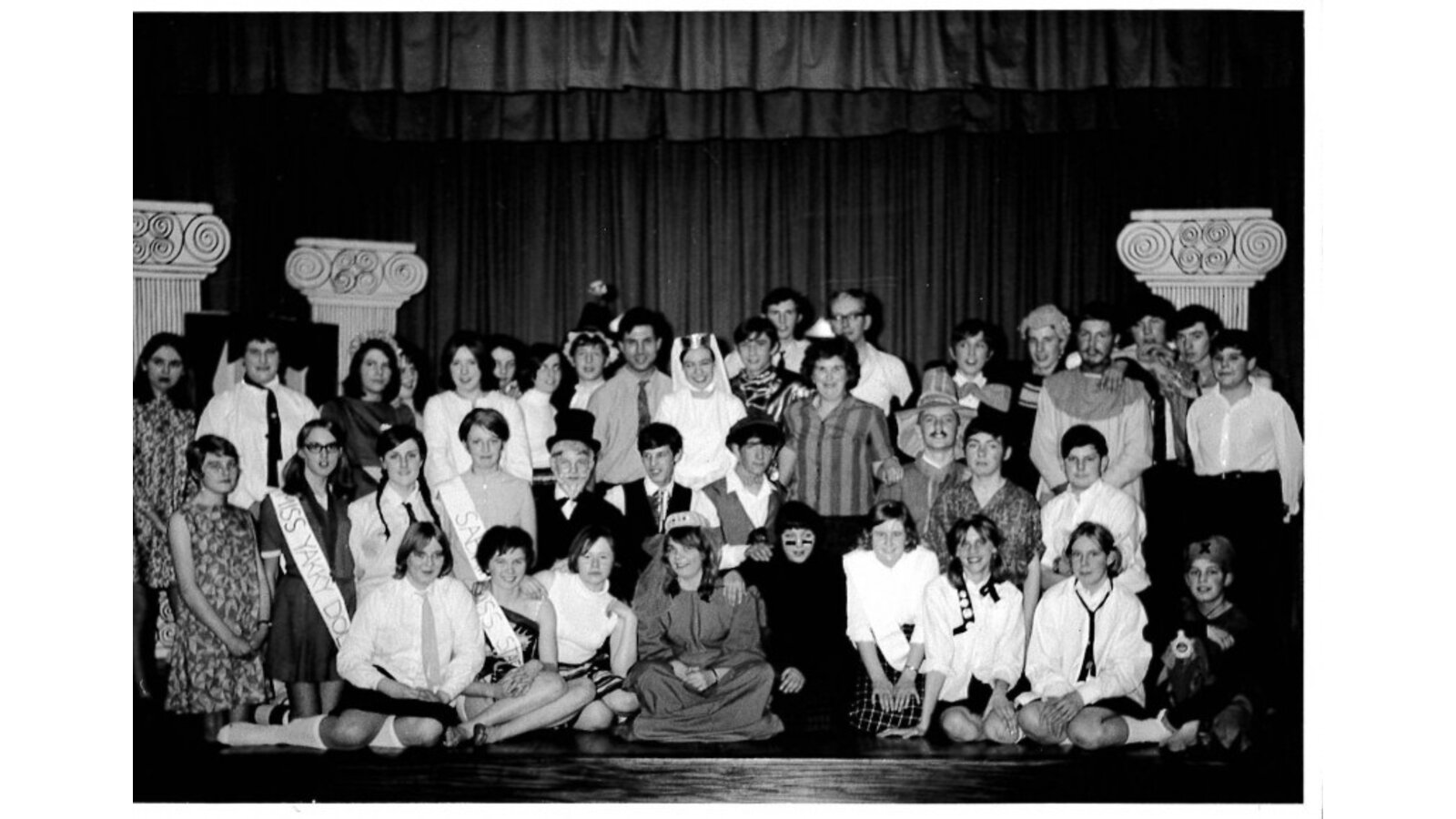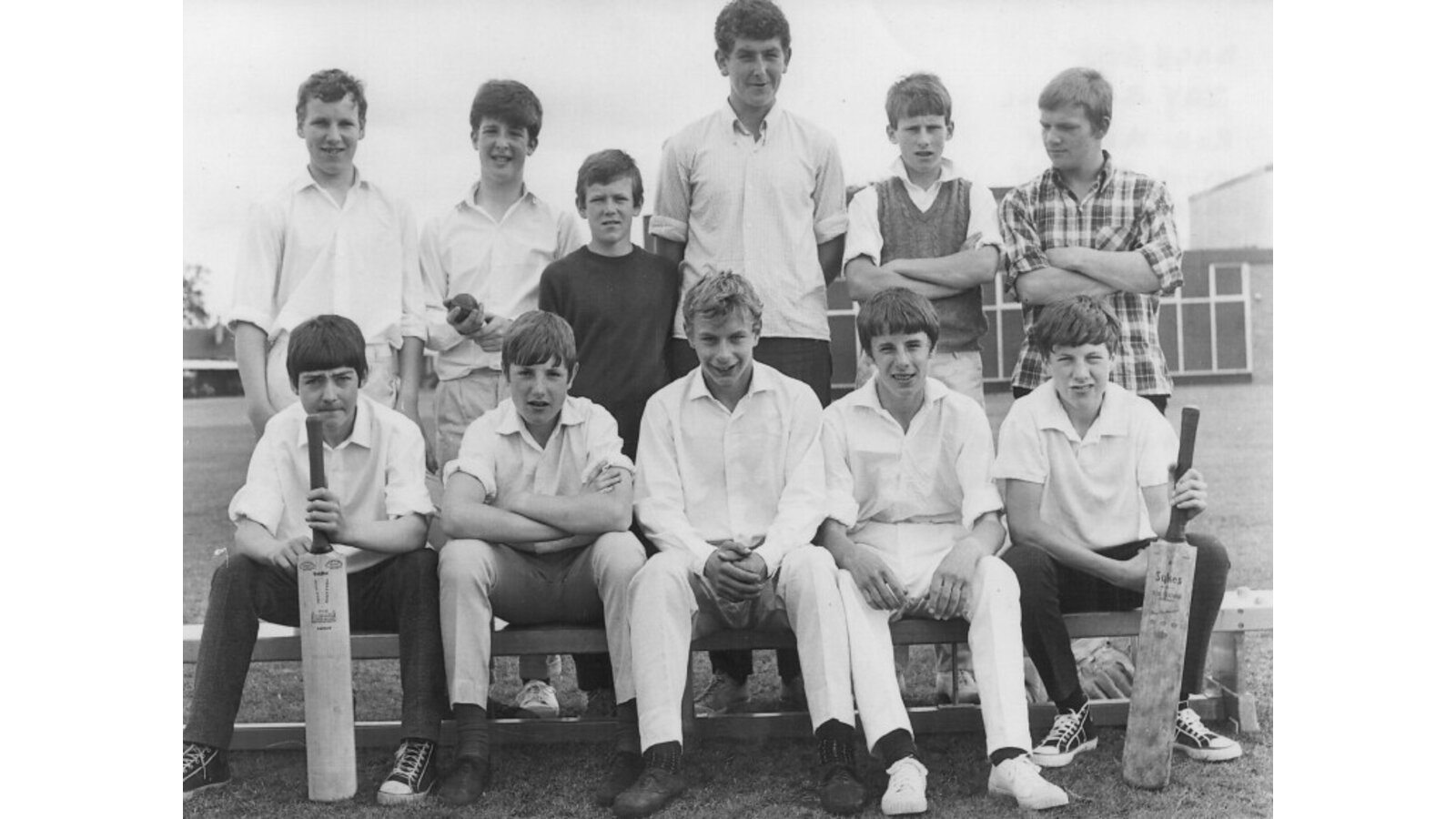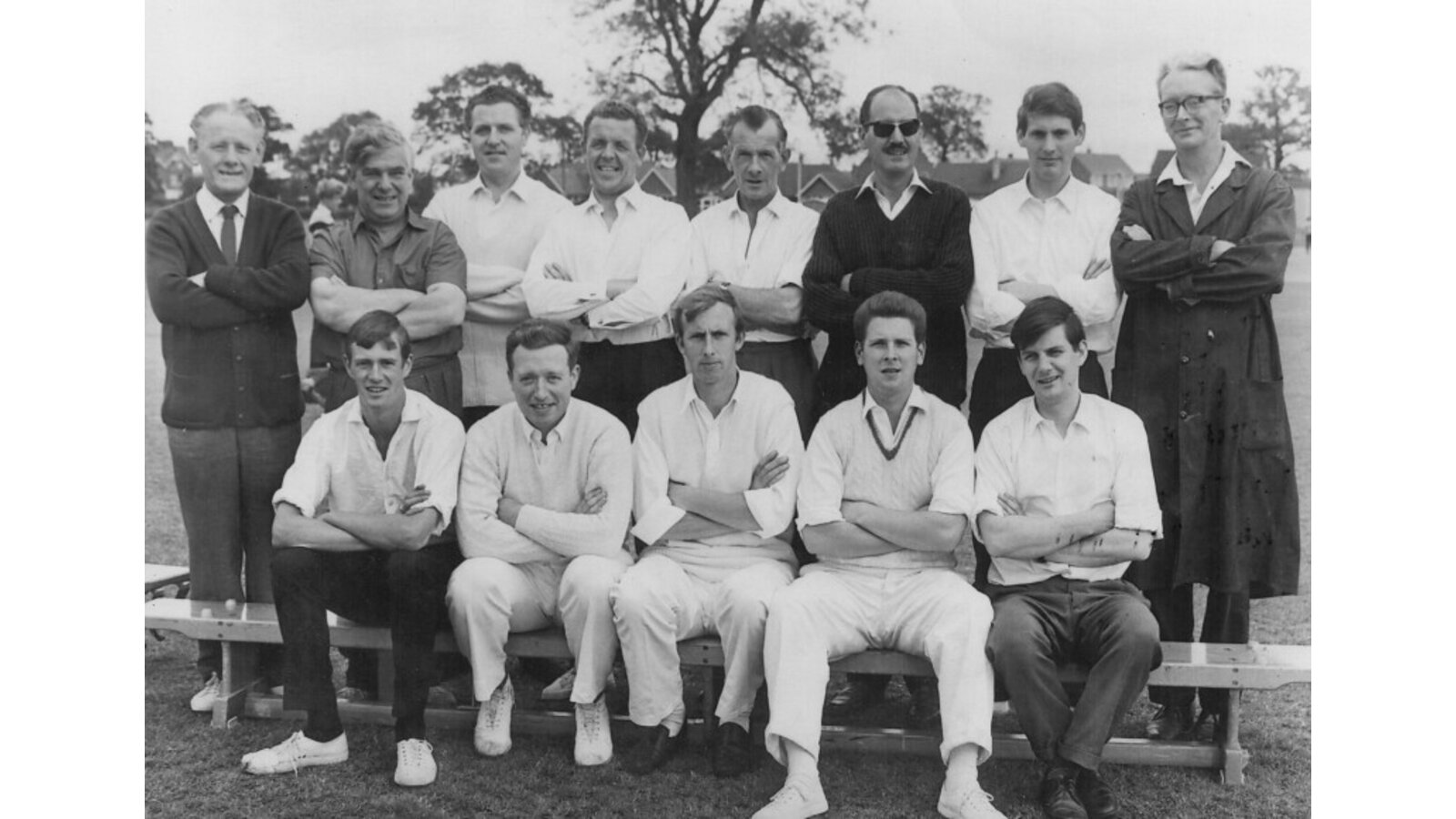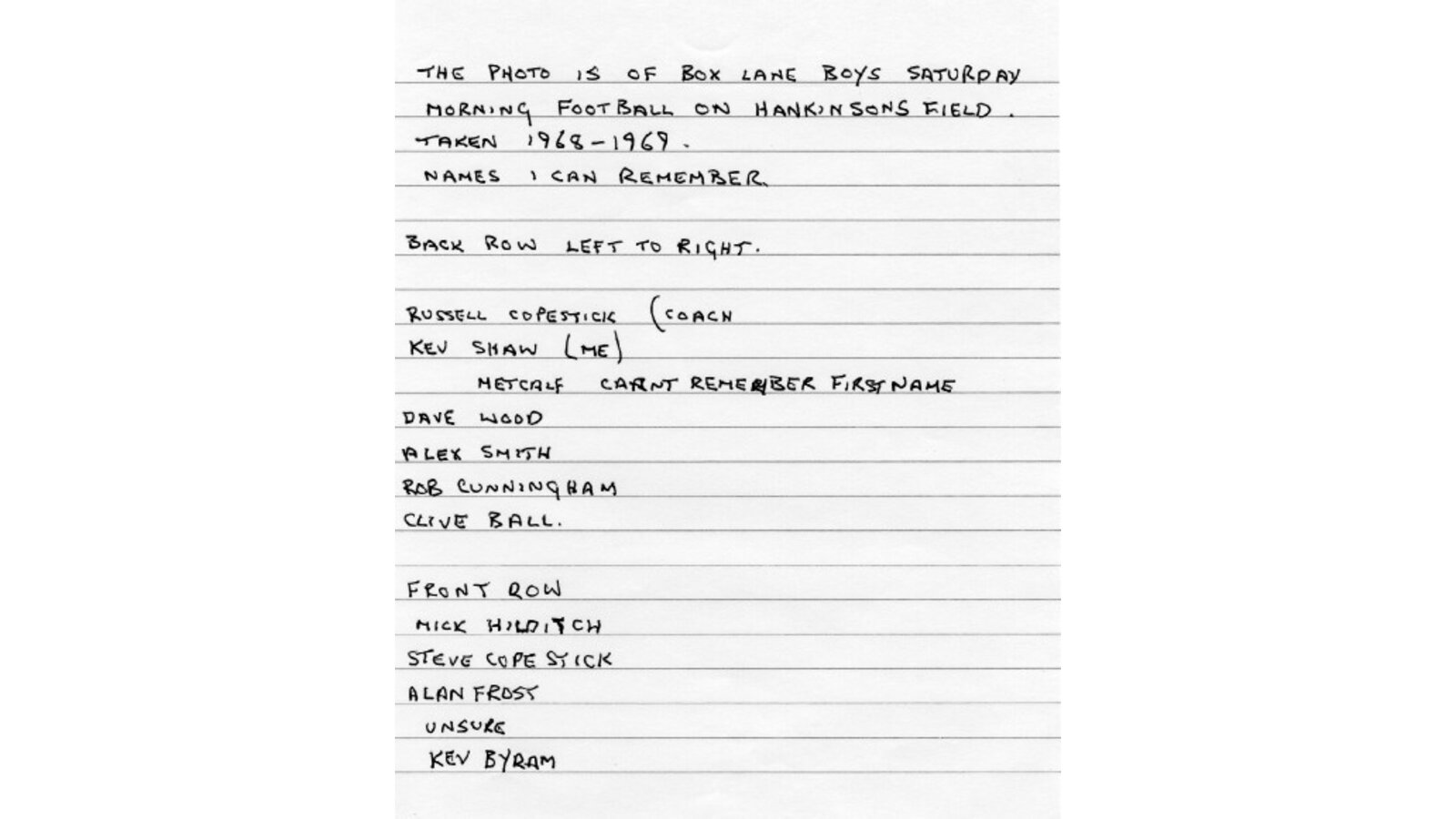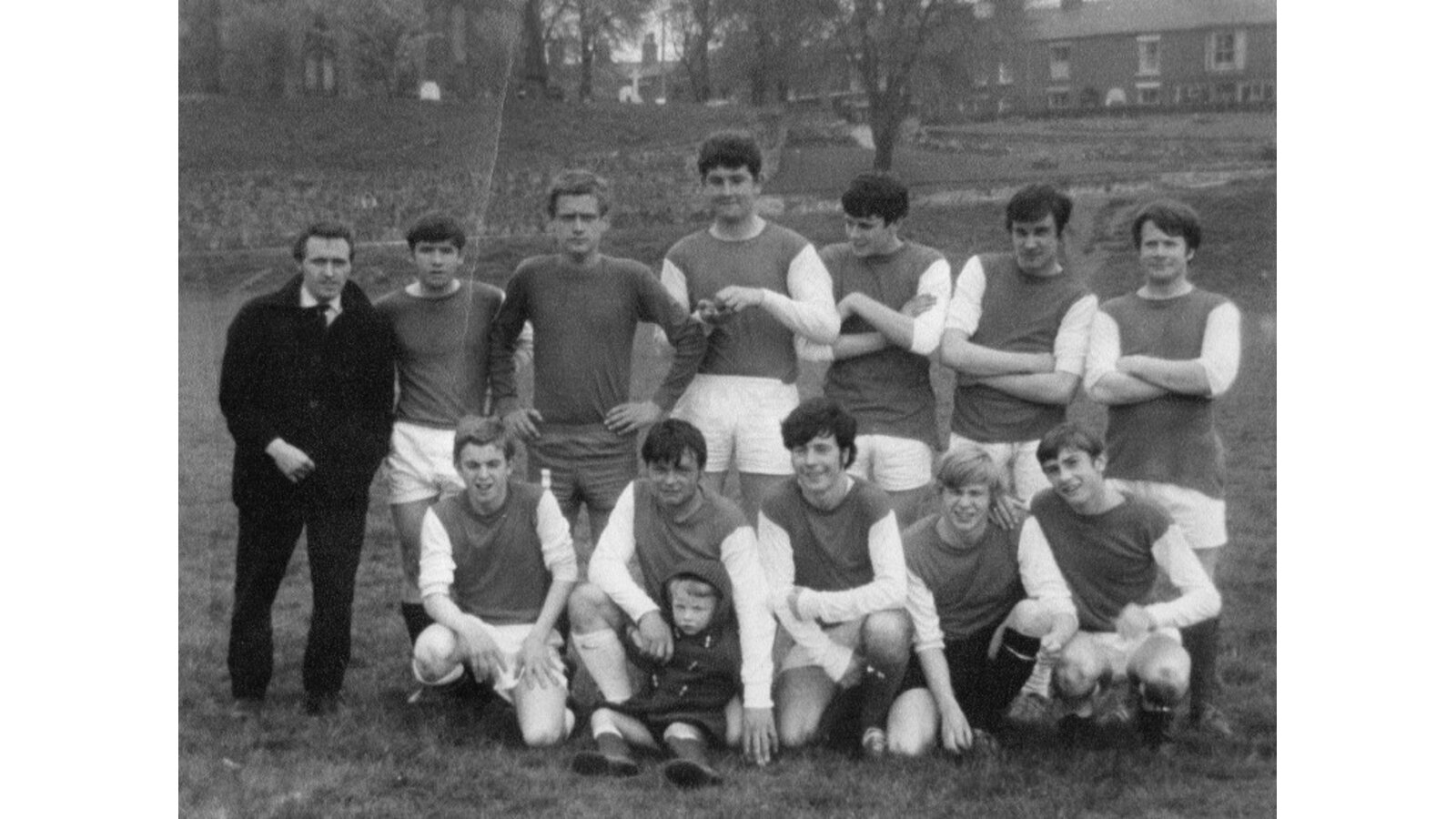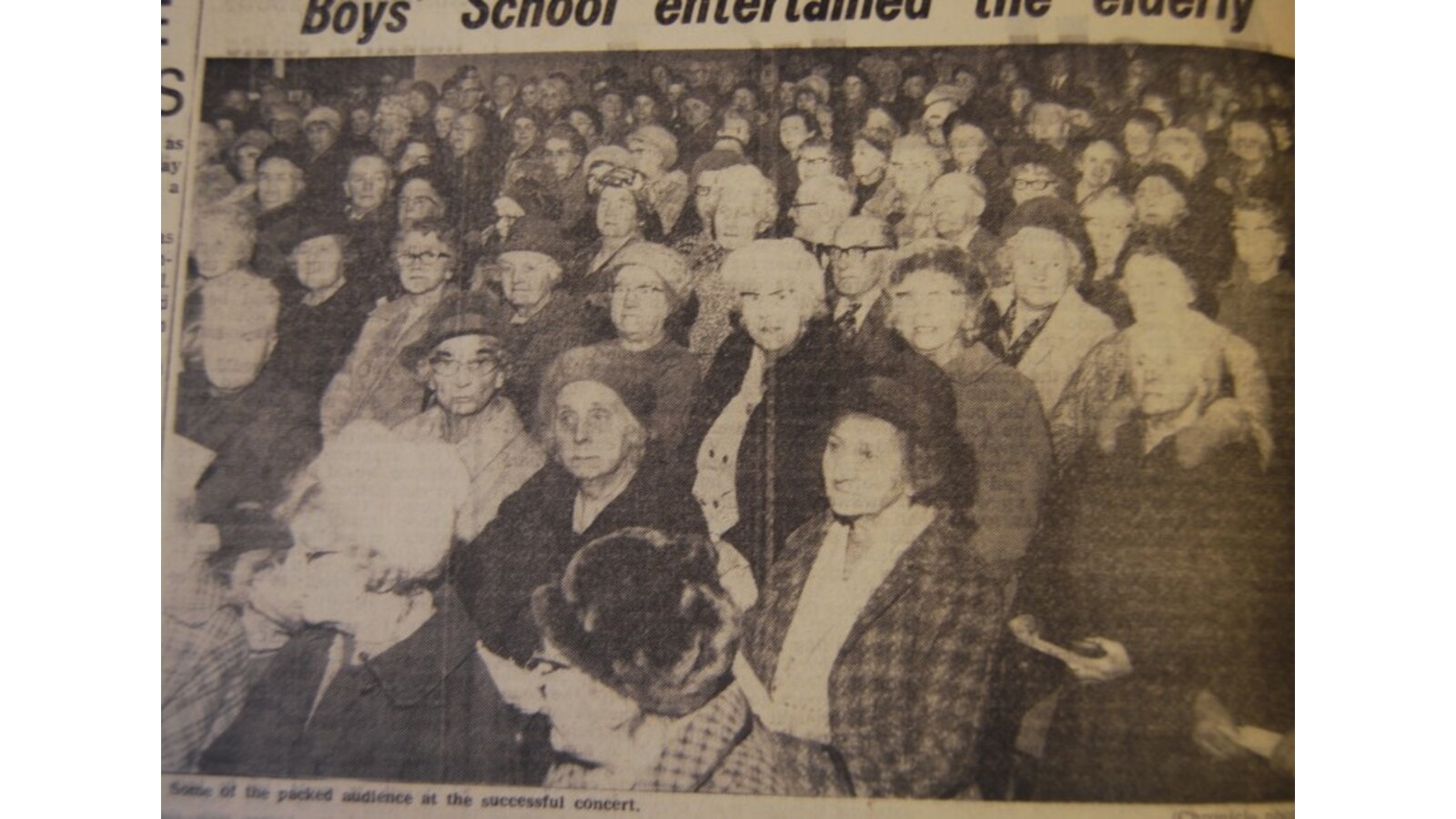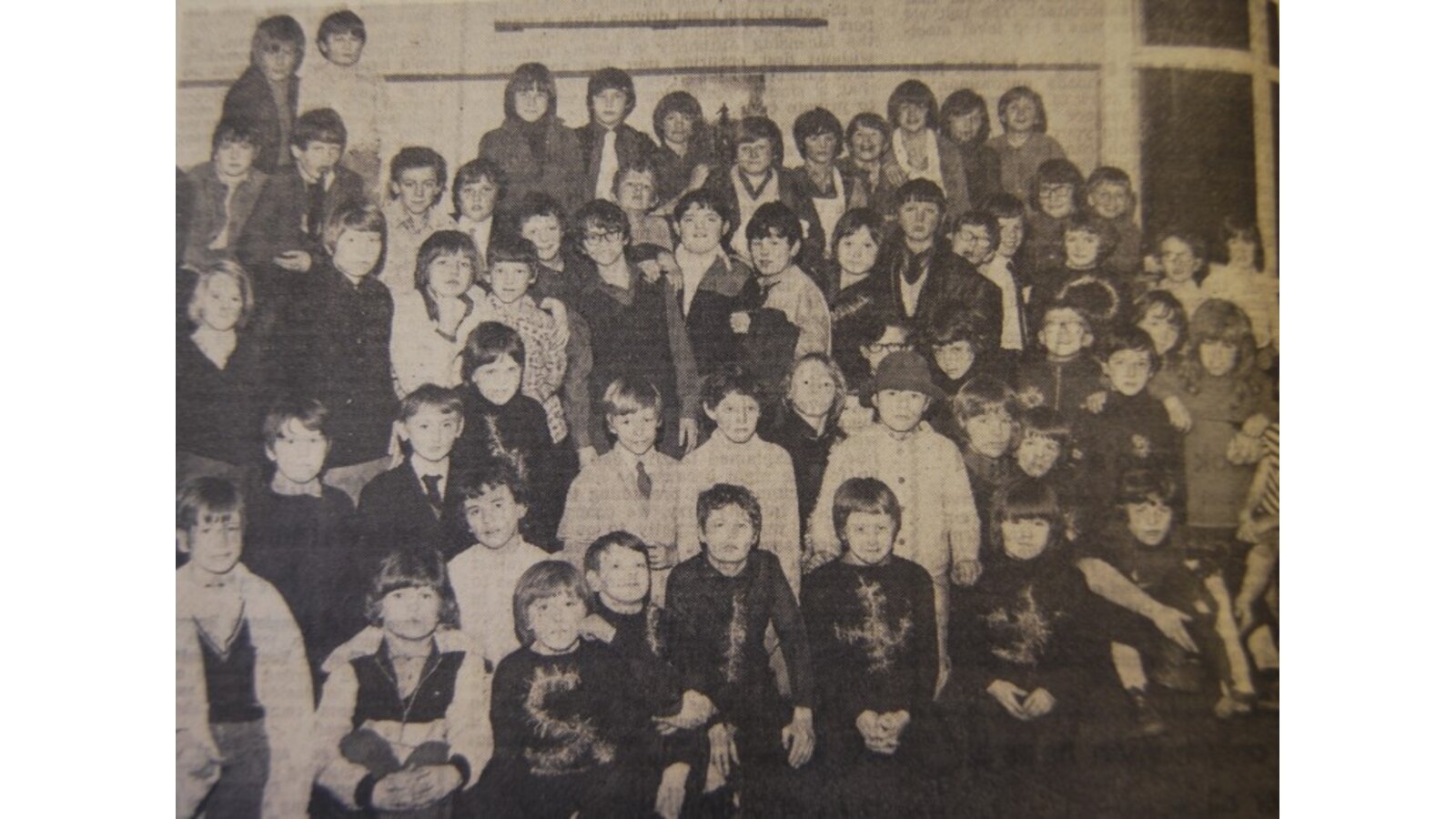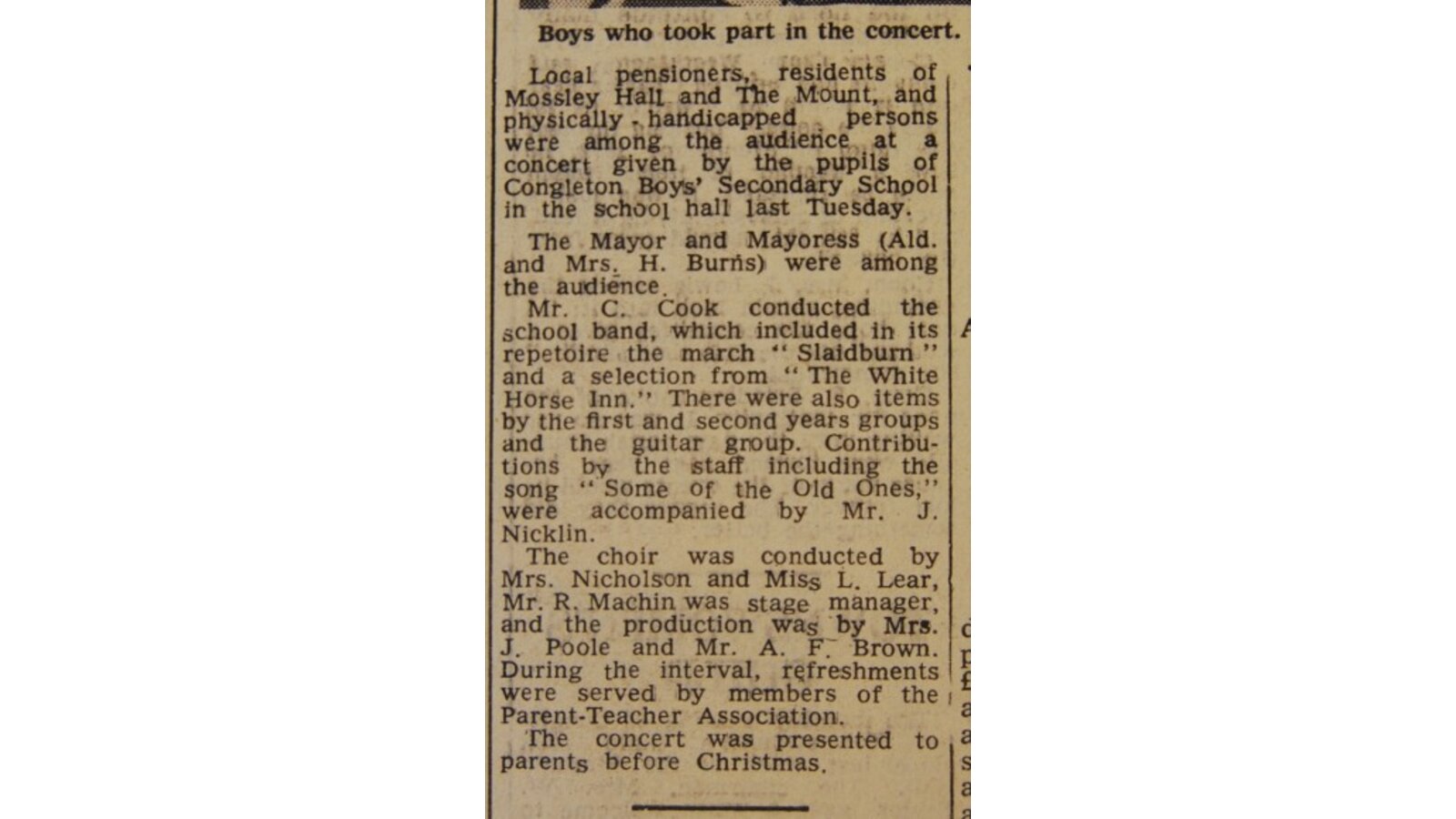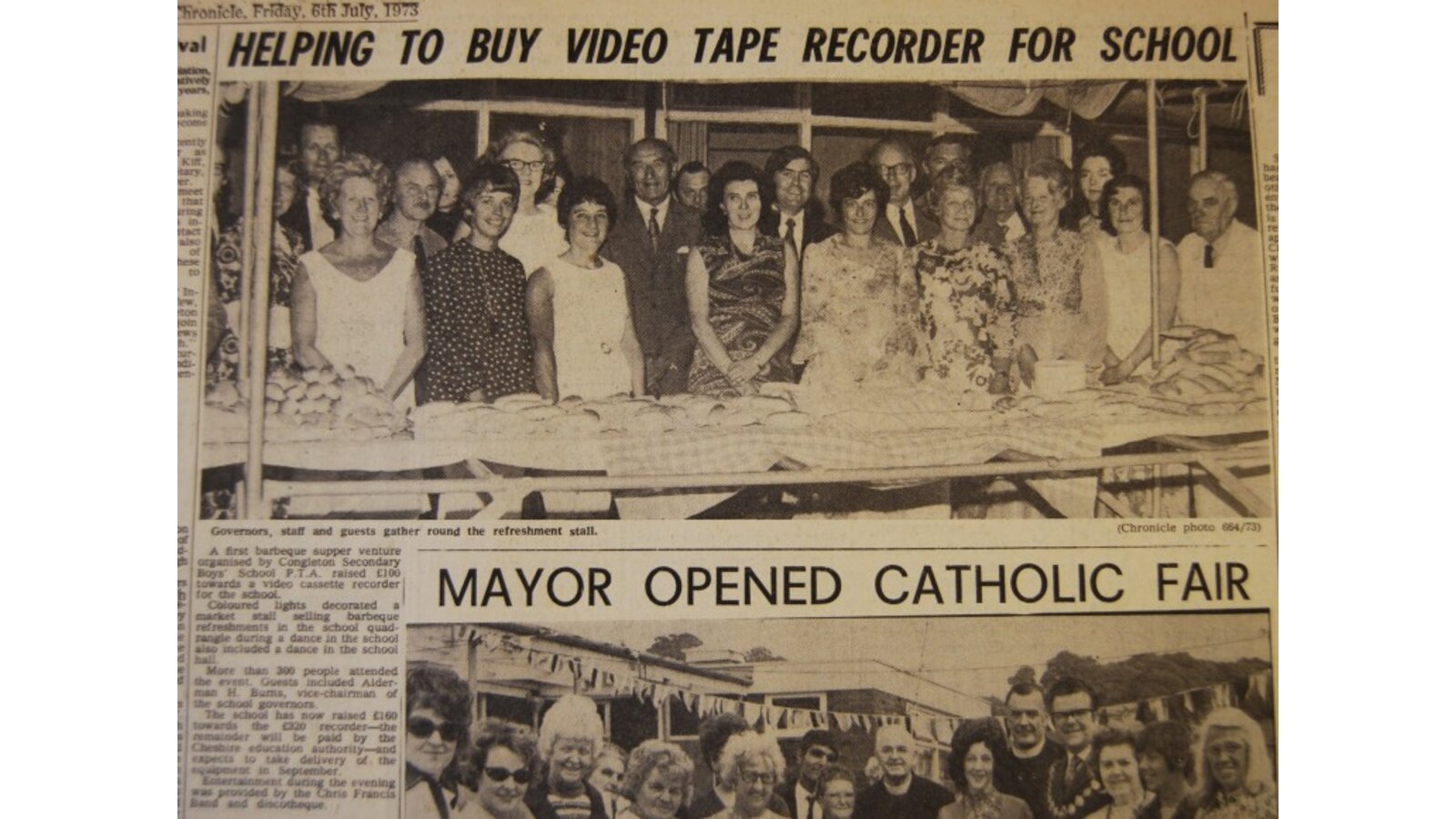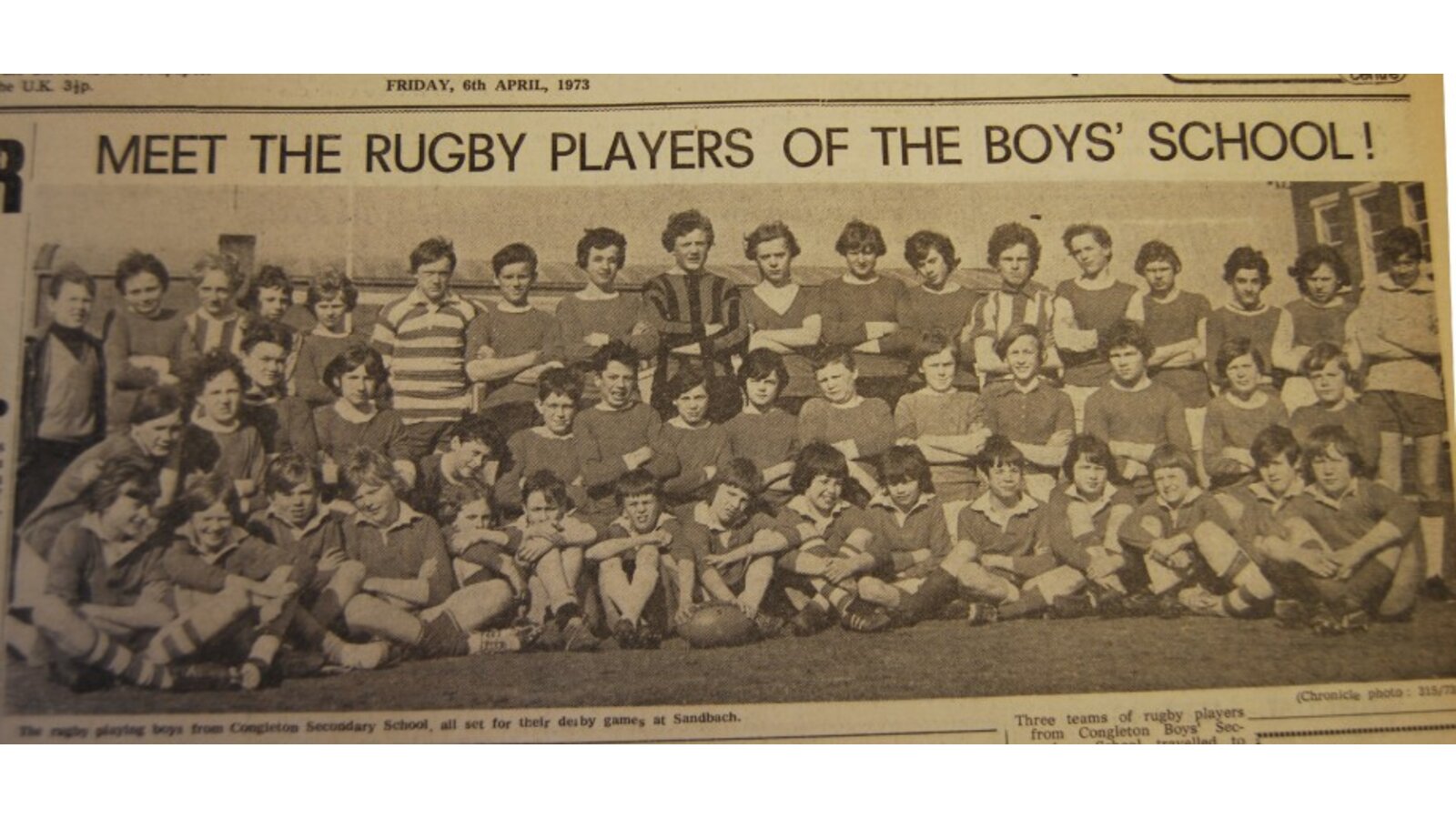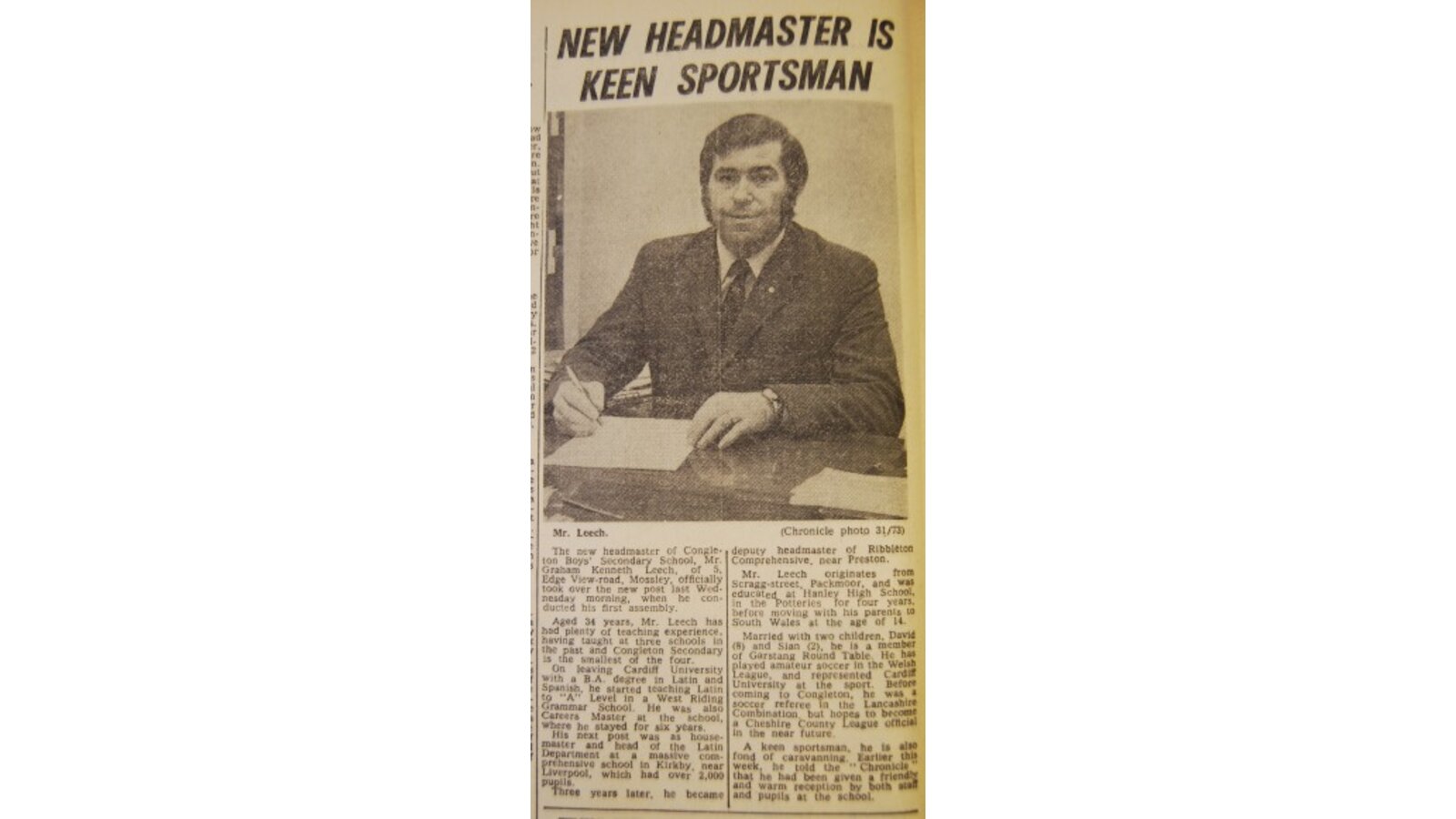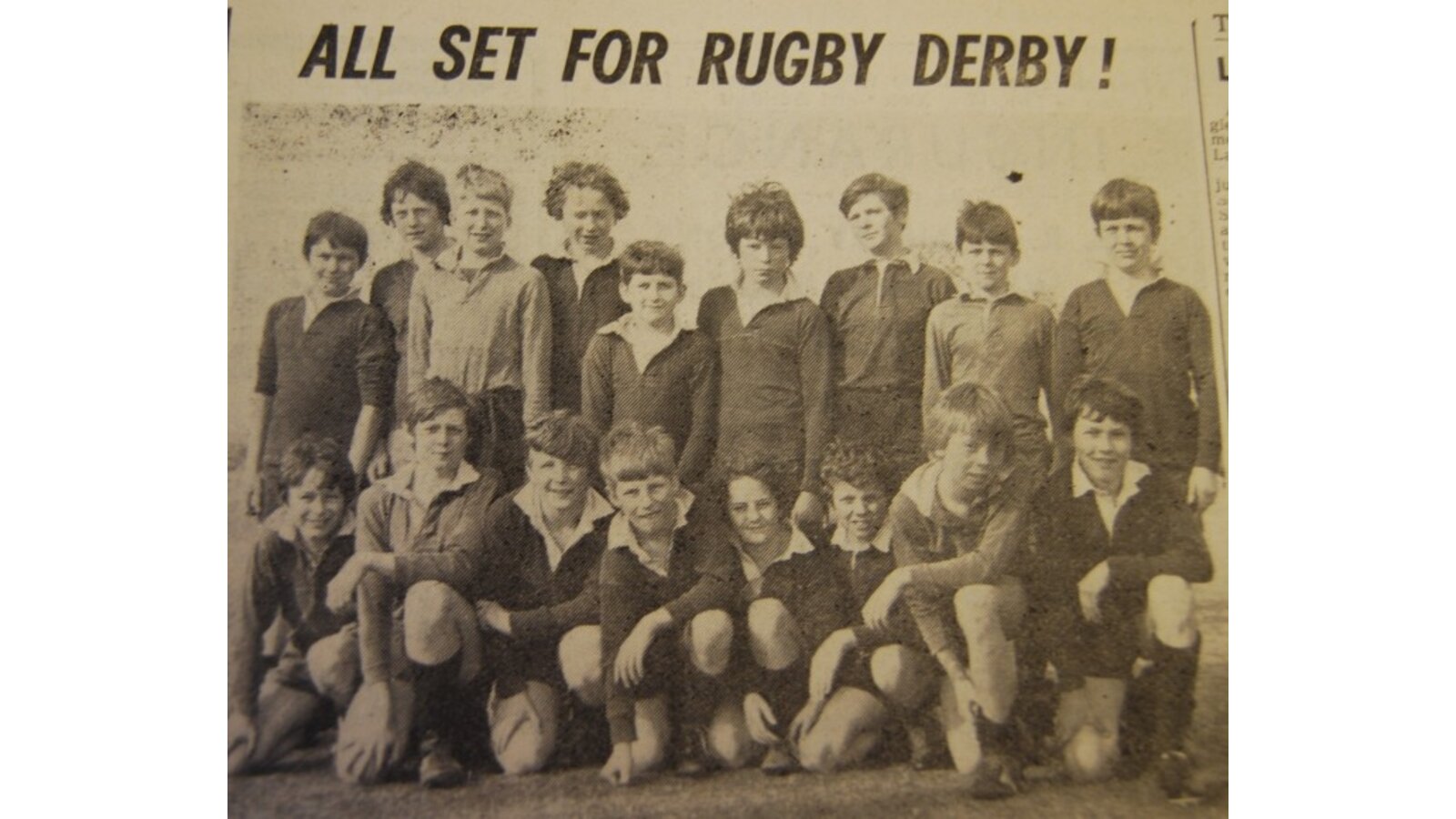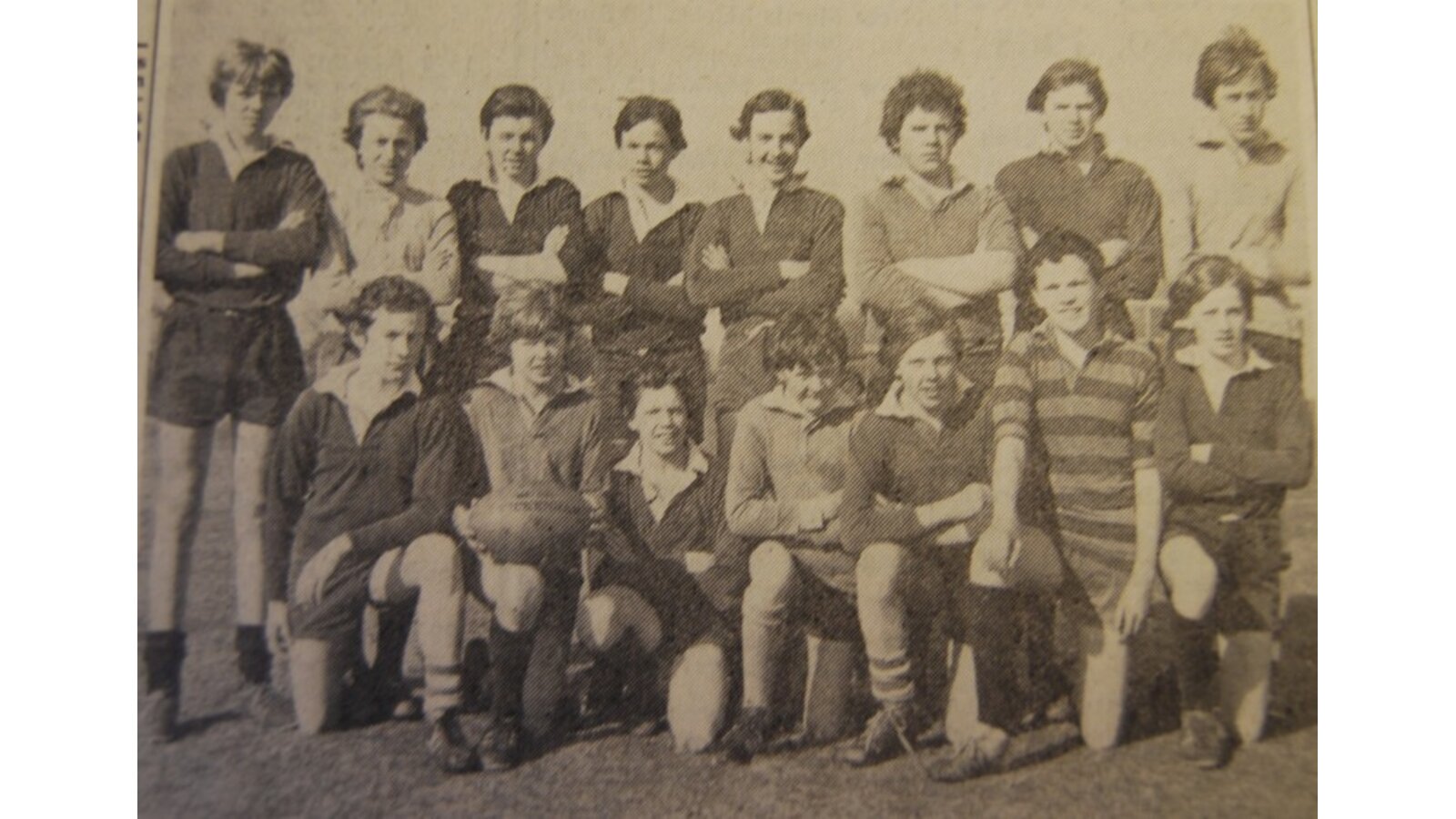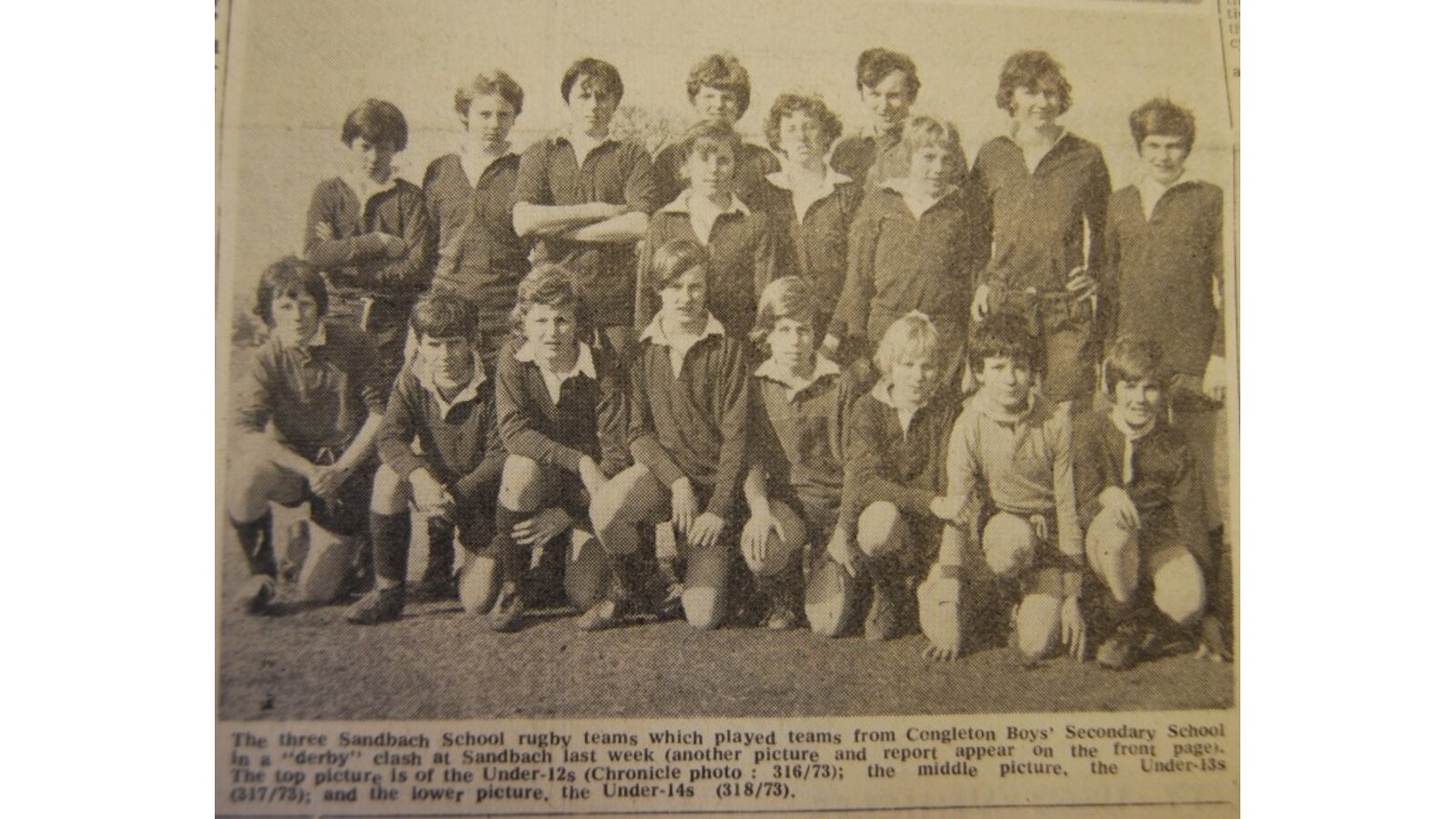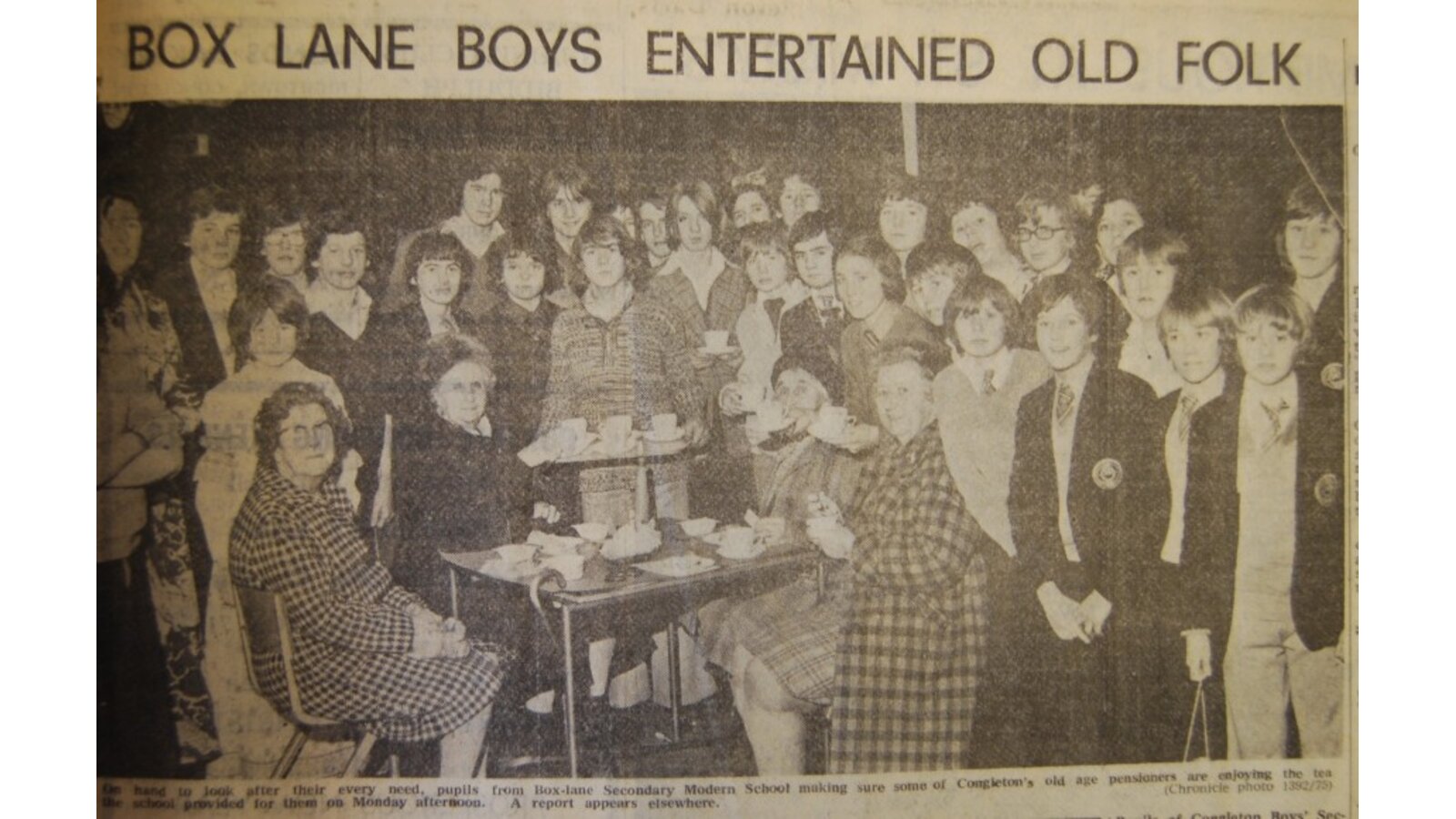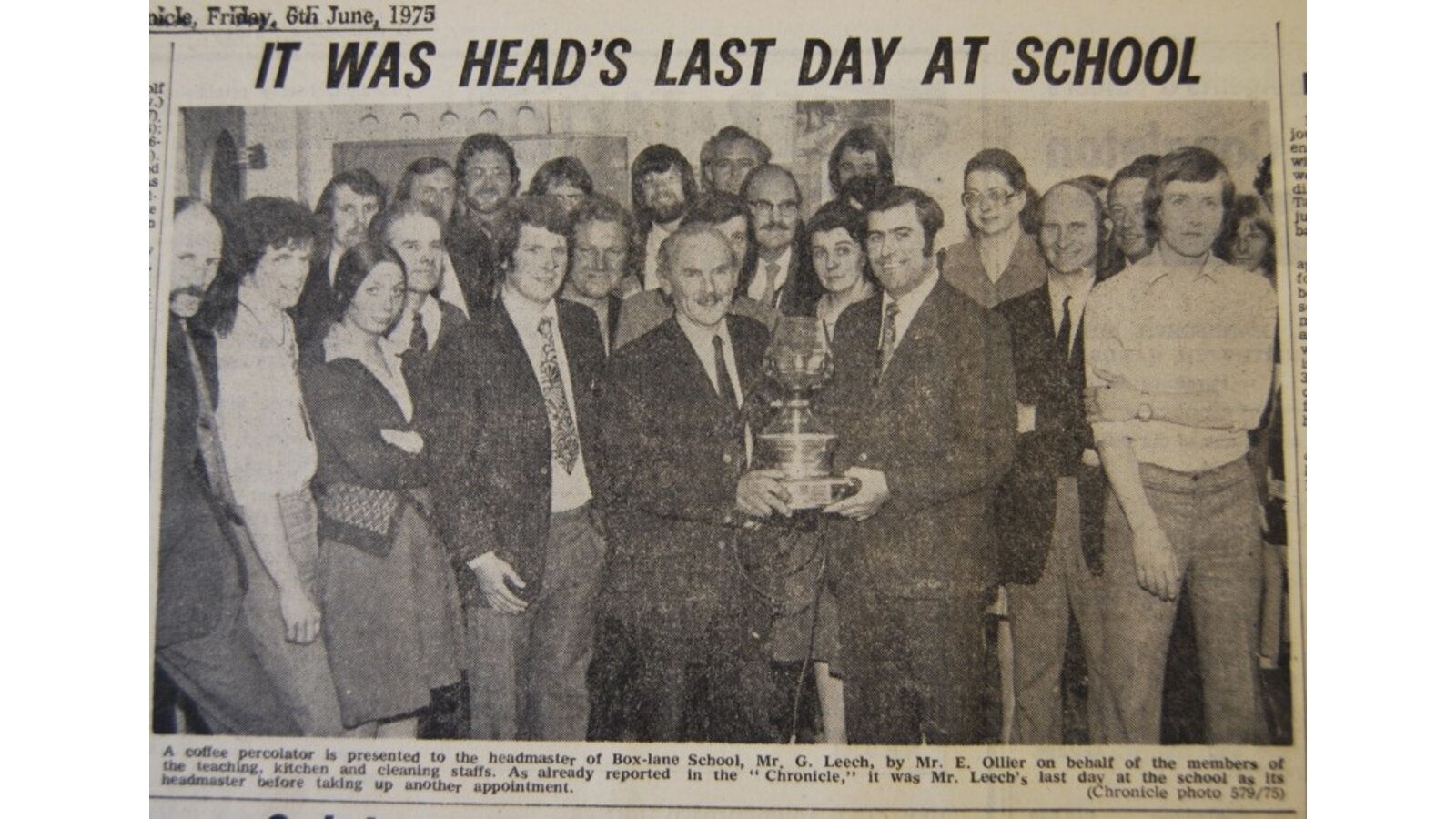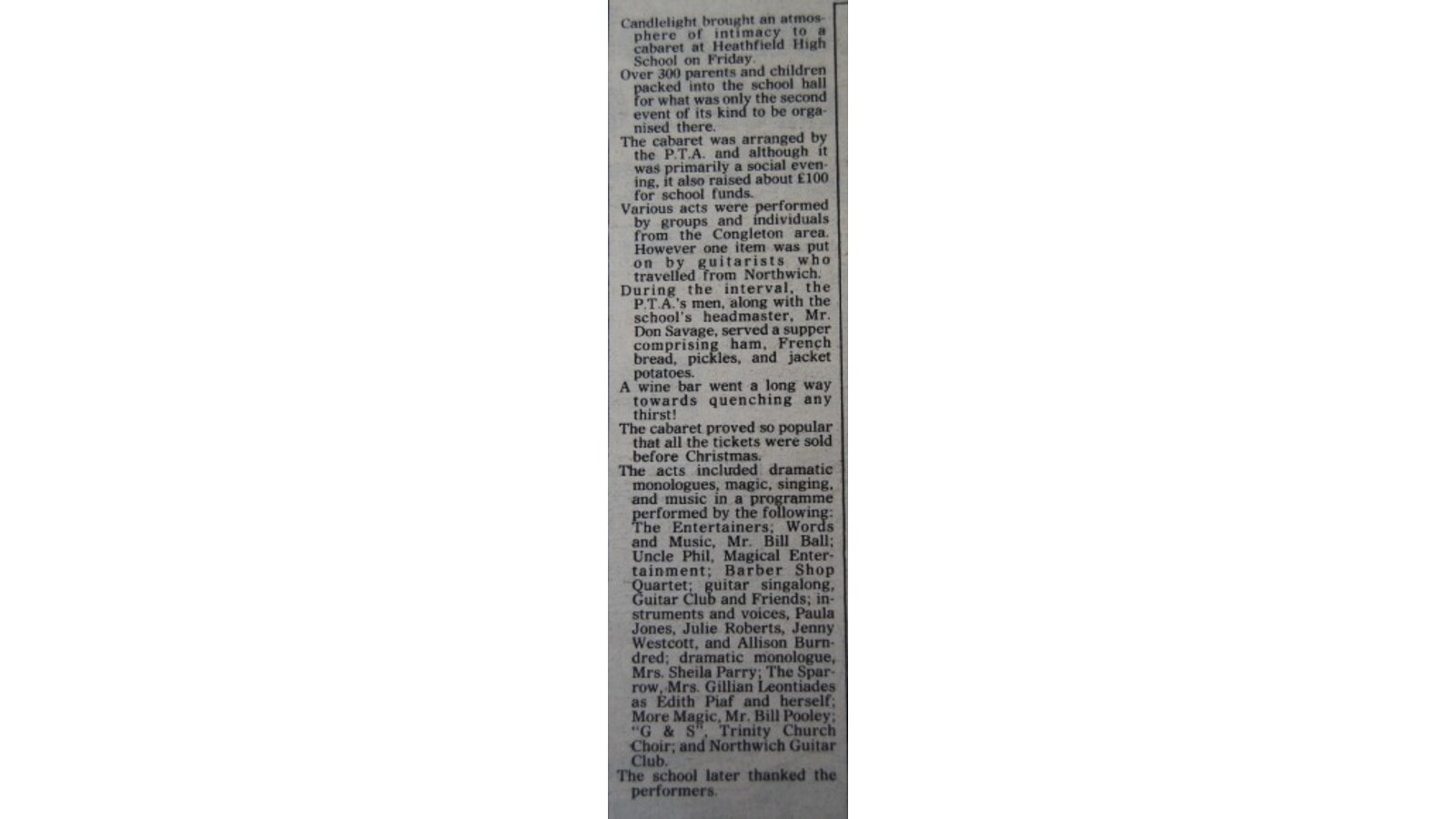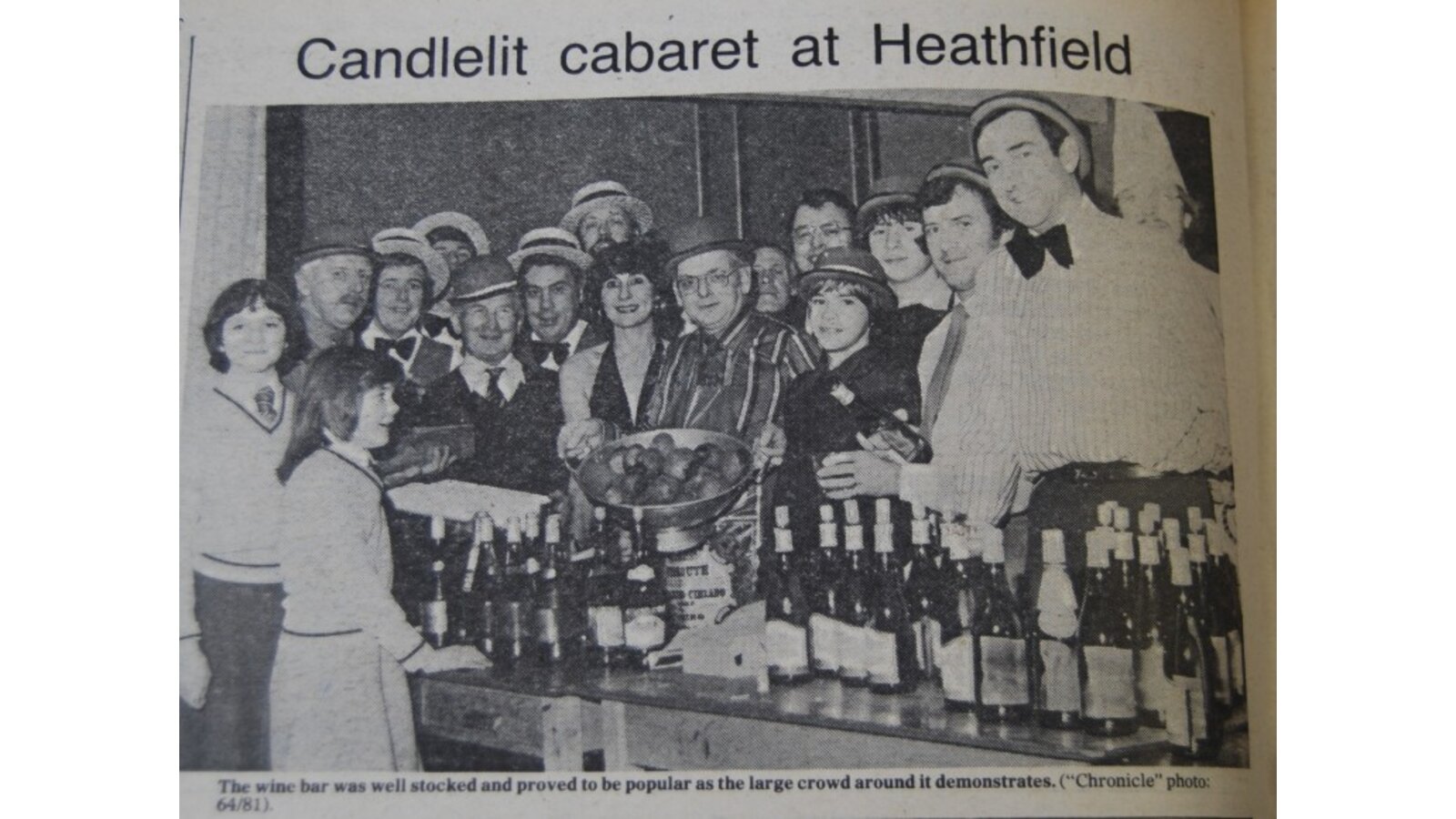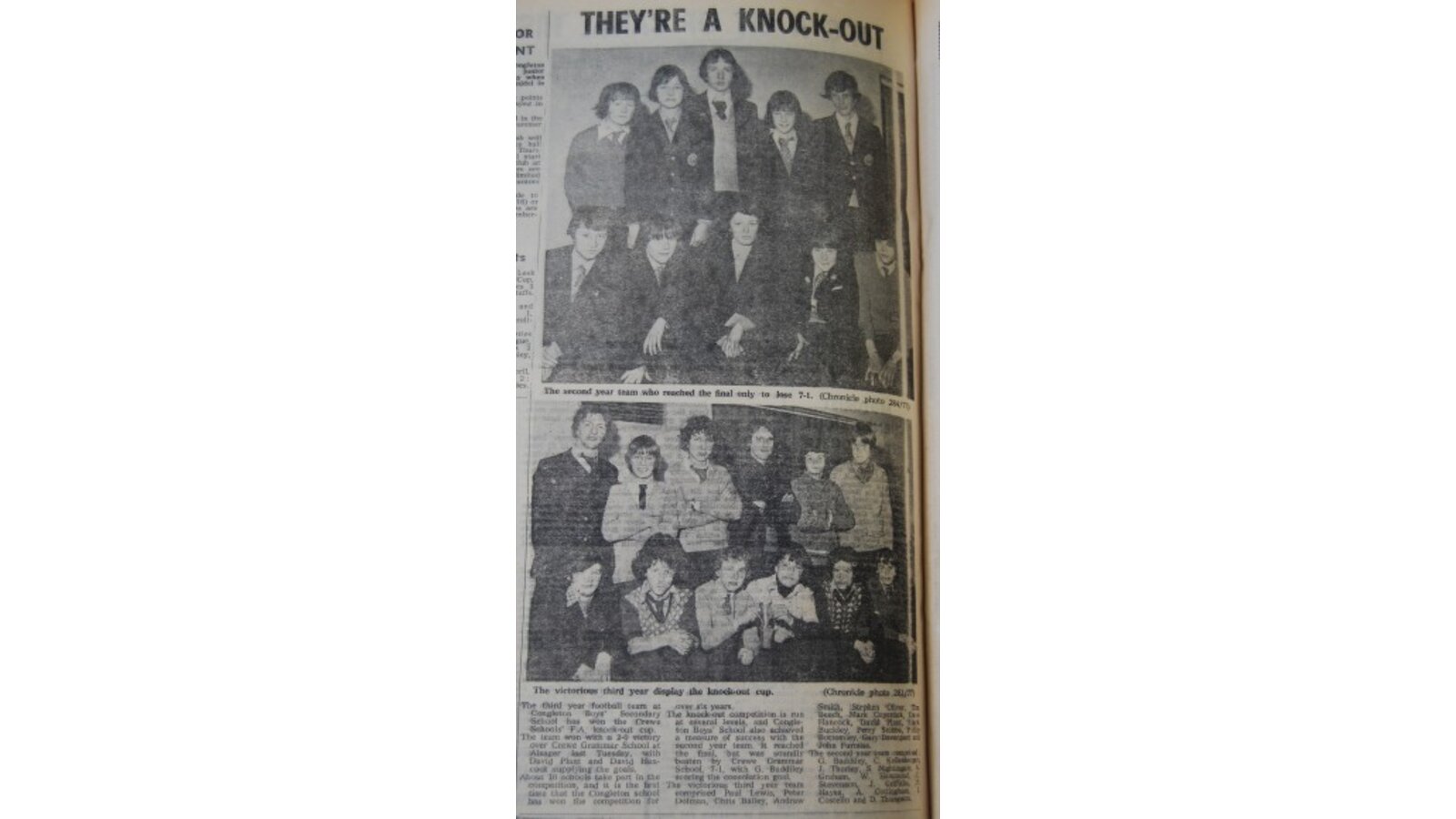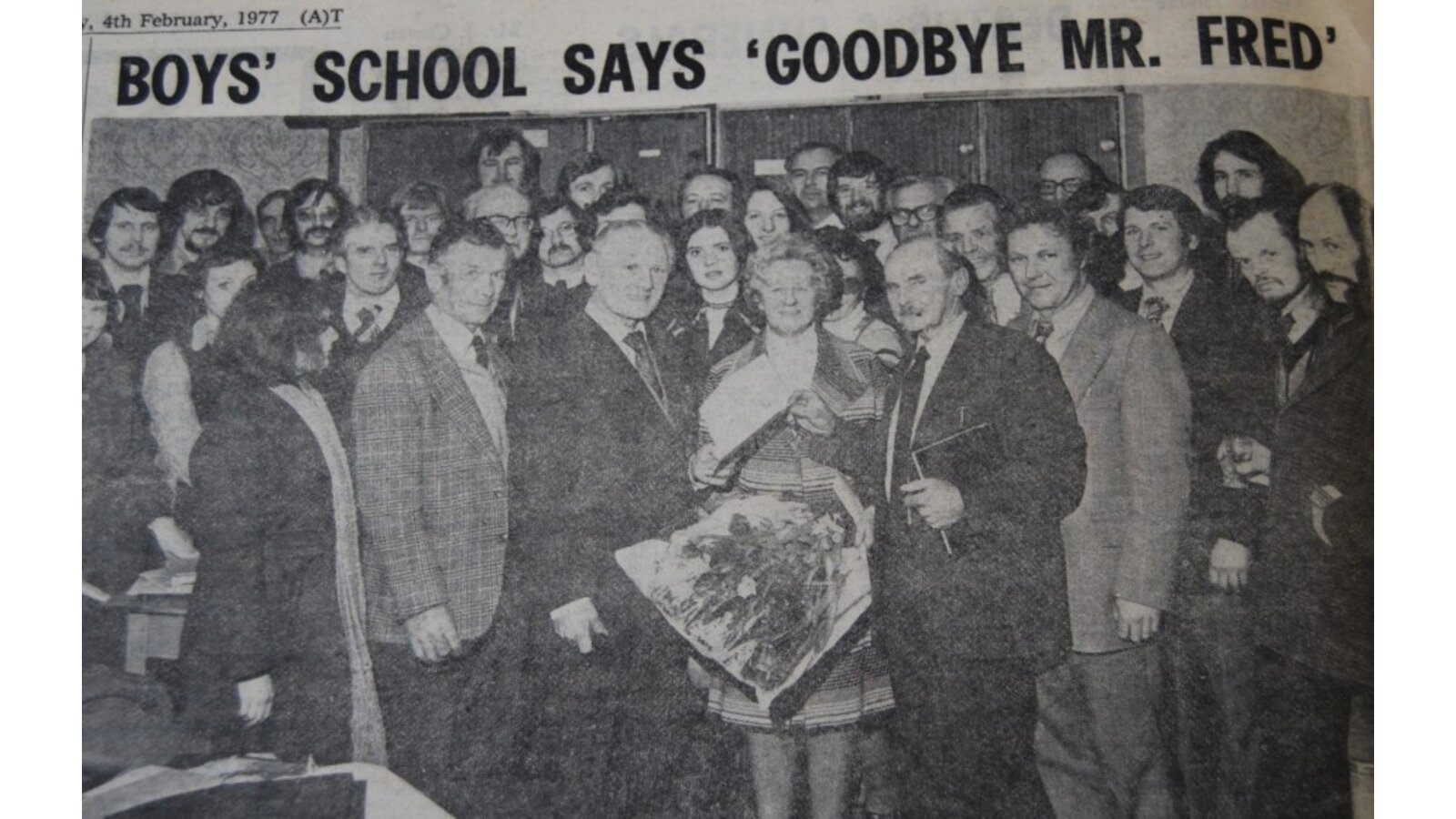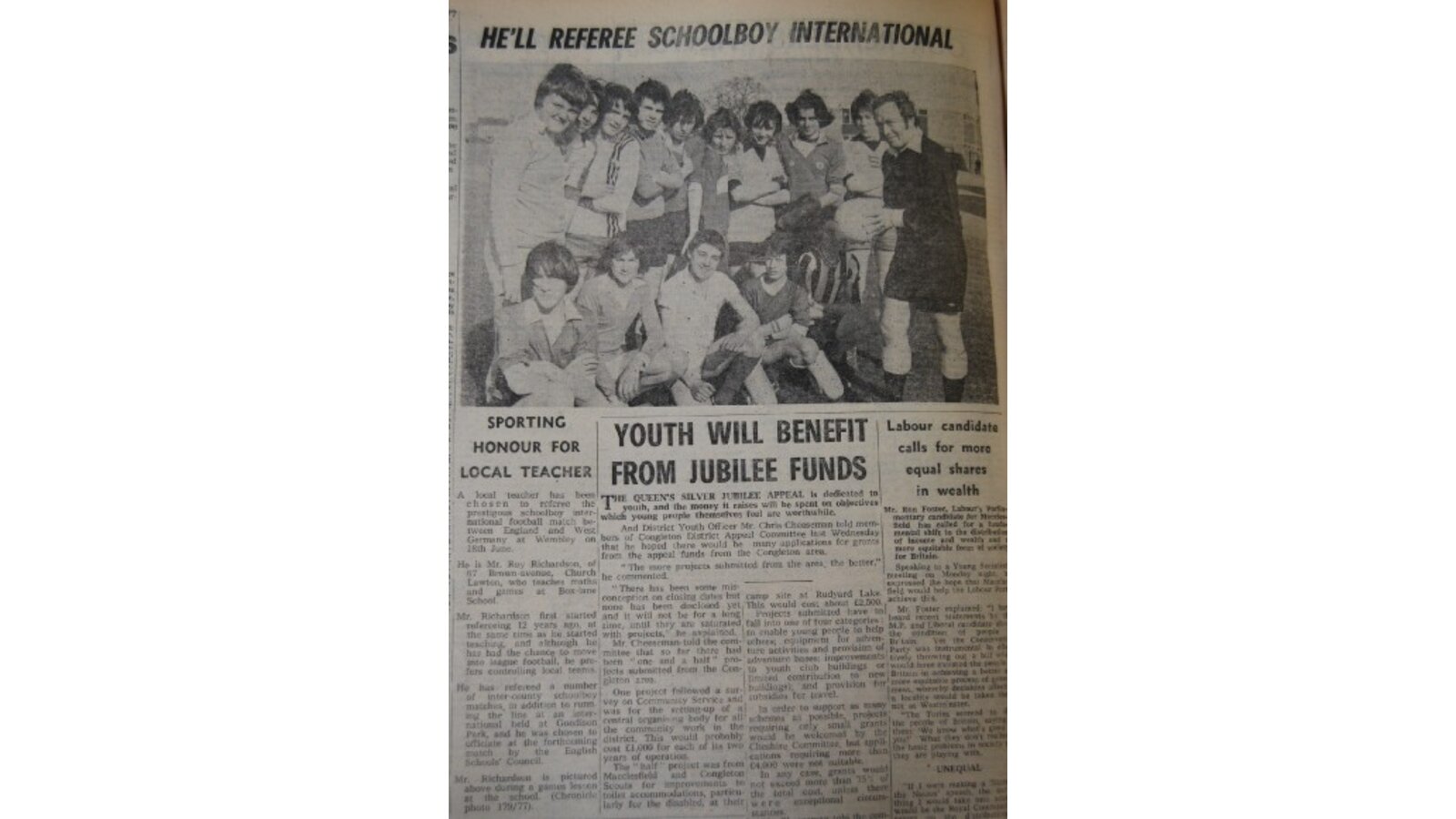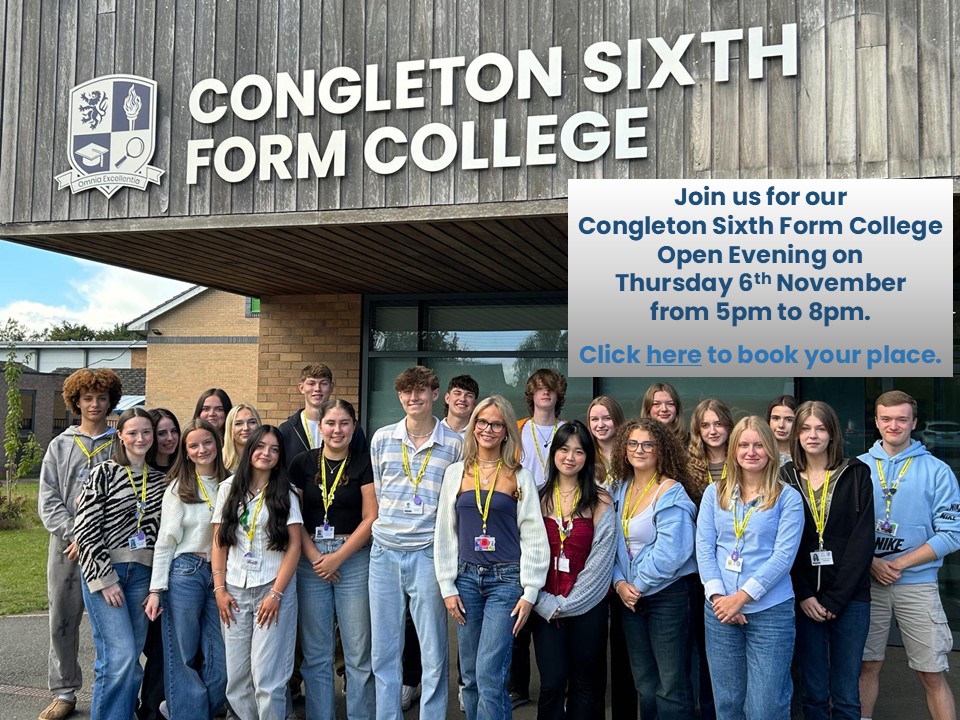Congleton County Secondary School for Boys (1964 - 1979)
First days
According to the programme from the official opening, the Congleton County Secondary School for Boys was “the 46th secondary school to be official opened since the inception, in 1949, of the County Education Committee’s Annual Building Programmes.” The existing boys school moved from its premises on Waggs Road in Congleton (now Marlfields Primary School) to the new school buildings on Box Lane in October 1964. It was designed by the County Architect, Mr E Taberner and built by Messrs A J Pass & Sons Ltd. The programme from the official opening records that “The total cost of the buildings, furniture and equipment and the lay-out of the playing fields amounts to approximately £222,000.”
One former teacher, Roland Machin, started work at the boys school in 1963 and subsequently worked at all 3 schools over a period of 38 years. He recalls that the new school wasn’t ready for the start of the new school year in September and so they didn’t move in until the October. “There were contingencies including a stream running under the middle of the school, which was the reason for the delay as they had to sort out the drainage.”
Nigel Watson was a student at the time and he remembers what it was like: “On the first day of the school opening, I remember the school field was like a First World War Battlefield. There was no grass, just earth with trenches dug for drainage. A tarmac playground with a tree at the edge away from the school was ready for use. Everything seemed big and new to me as I was straight from junior school.”
Cattle truck
Mr Machin recalls: “We borrowed Mr Lomas’ cattle truck over the weekend to effect the move. There were about 375 boys from all over Congleton and surrounding areas.” He also recalls the original Headteacher, Mr Harold Shanassy, who had opened the school in 1937 was highly respected in the town and by the LEA though sometimes quite relaxed. “Before I joined the school I rang him to find out when school term was due to start ,he didn’t know. In fact, no-one seemed to know. In the end I had to ask some of the boys in the town!”
Opening Ceremony
The official opening ceremony wasn’t performed until 7:30pm on Friday 19 March 1965, when the school was officially opened by Sir Wesley Emberton, Deputy Lieutenant and Chairman of the County Council. The buildings were declared open and handed over to the Governors, Chaired by W H Semper Esq. The hymn ‘All People That on Earth Do Dwell’ was then sung and prayers and thanks were said. The ceremony ended with the singing of the National Anthem, following which the school was open for inspection.
Officer’s Mess
Mr Machin, nicknamed ‘Scratcher’ also recalled that many of the original teachers had fought in the war. “The staff room was a not unlike an officer’s mess in those days. At break and lunchtime teachers would be smoking, playing chess and reading The Guardian. And of course there were no female teachers until the early 1970s. Sandy Farmer was the first, and then Pat Smith”
Curriculum
Even back in the 1960s, the school was very strong on engineering. Mr Machin: “There was no national curriculum in those days - the school and individual staff built their own curriculum.”
Congleton County Secondary School took boys from Congleton and surrounding areas from the age of 11 until 15. Boys who passed the 11+ exam went to Sandbach Boys school. According to the programme from the official opening, the school provided “a general course of education for pupils in their first two years , including such subjects as English, mathematics, history, geography, science, art, music, religious instruction, physical education, woodwork and metalwork.” Then at age 13, in addition to their general education, boys were selected to follow one of the three Alternative Courses – technical, rural studies or practical. The technical course included such subjects as mathematics, science, woodwork, metalwork and technical drawing. Rural studies included horticulture, agriculture, livestock keeping and rural science whilst the practical course included woodwork and gardening. The school even had its own allotment at the back where the current tennis courts are.
Former Headteacher, Don Savage also recalls that the school won a curriculum award in the early 1970s. “Jean Wilde was our Director of Studies. She was brilliant – the kids loved her. We had to present our curriculum ideas and we won an award. We went to London with some students to collect it and were presented with a certificate and a painting by the speaker of the House of Commons. The painting used to hang in school.”
Right from the start, the school’s strengths were in practical work, PE and, above all, Engineering. As now, the school had links with local industry such as Bentley Motors and with the Crewe works (British Rail). A lot of boys went into engineering or farming. Don Savage remembers that “Local companies like Fodens and Rolls Royce and also British Rail were desperate for our kids to become apprentices.”
Mr Machin developed Motor Vehicle Studies as a vocational school based examination subject. He enthused generations of students in the subject and even had doors put on the side of the Technology workshop so that they could build a car in school and get it in and out of the building. The photograph below shows the car that the students built for the BP Build-a-car competition (in the early 1970s). The competition was to build a car that was manoeuvrable around town.
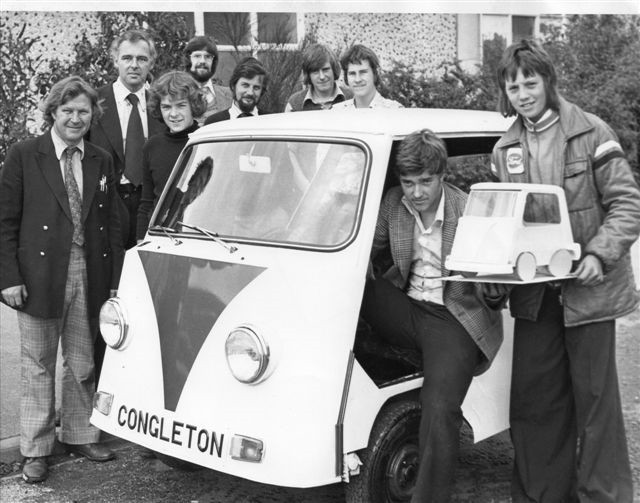
Former Art teacher, Bob Griffiths, recalls that Art used to be upstairs in the main teaching block. “We had a ‘light craft’ room where we did basket weaving, cane seating, resin casting and book binding. Then boys also did ceramics and painting and drawing.”
As part of their physical education, boys had to do a cross country run, which set out from school across Loachbrook farm, past the Wagon & Horses, onto Back Lane, then Black Firs Lane, finishing with a lap of the school field. Former students Peter Plant and Chris Jones remember it well. “You always had to do this cross country circuit and you had to cross the Loach Brook. The 4th years would stand by the deepest part of the brook and make sure that every boy went right through it. And there were no shortcuts – there would always be a member of staff on a bike waiting in case you decided to try and nip back across the fields.”
The School Day
As Roland Machin recalls, the school day started at 9am. “Staff blew a whistle and the boys lined up in their form groups. The same happened at break and lunchtimes. The lunch break was about an hour and a half, giving boys plenty of time for activities and staff enough time to go to the pub, including Mow Cop!”
Former student Peter Plant recalled how things were for the boys at lunchtimes “You sat at large mixed tables with students from different years. Each one had a Head of Table and two servers, usually 4th or 5th years. Nine times out of ten, the Head and Servers got half the tin of food and the rest went to the ‘menials’!” “You had red dinner tickets, which were 2 shillings a week. Then it went up to 2 and 6 and later to 5p. Later on they stopped serving it at the tables and boys had to line up. Then it became a free-for-all; when the bell rang, you just ran!”
Nowadays parents and students are in touch directly with teaching staff and tutors via the telephone and e-mail. But as Mr Machin recalls, things were very different in those days. “Once school had started each day the caretaker Fred Snelson closed the gates– parents only came to school by invitation.”
Former student, Chris Jones, remembers that the school had different ‘houses’ and that everything was done in these different groups. “Originally we had St Patrick, St David, St Andrew and St George, but in about 1973 these changed and we had Telford, Wedgewood and Brindley.” Chris and Peter remembered the Headteacher at the time – Mr Butterworth. “We called him ‘Strutter’ because he was a tall bloke and he used to strut about. He had a very old car too – a real bone shaker!”
As former student Nigel Watson recalls, there was an assembly every morning for hymns and prayers. “The school hymn was ‘He who would valiant be’ and the Headmaster, Mr Shanassy, led the assembly from the stage with the prefects sitting down behind him. The older boys at the back of the hall would only mumble the words, except when he got us to sing ‘The Battle Hymn of the Republic’ when they would sing ‘Glory, Glory Hallelujah’ as loud as they could!” He also remembers one occasion when a boy with long hair came in to the assembly late. “Mr Shanassy stopped the singing, got some money from his own pocket and gave it to the boy, telling him to go out again and get his hair cut!”
Uniform
Mr Machin recalls that they didn’t have a rigid uniform policy at the boys’ school; “There was a poverty in the town at the time – some pupils didn’t even have shoes or trousers.”
School trips and events
Mr Machin recalled that the school always took students to the Cheshire Show and to the Motor Show and later (in the 1970s) took trips abroad to France. He said “I remember we had a float in the Congleton Carnival each year, including a psychedelic car in the early 1970s. The school also owned a 42 seater Bedford bus. Teachers had to do a 2-day driver training course to be able to drive it and they used it for day trips out. It only had a top speed of 47 mph and the Rural Studies teacher used to collect muck in it, so sometimes it smelled awful! We used to use the fire hose to clean it out.”
There was a strong tradition of outdoor pursuits at the school, as former Art teacher, Bob Griffiths remembers “Boys did sailing at Tatton Park, Redesmere and Menai under the leadership of teacher Geoff Watson; rock climbing under the leadership of teacher Graham Cole and canoeing and kayaking led by teacher Roy Curtis.” He also fondly remembers a funny story that happened one snowy lunchtime. “For a while I ran a lunchtime running club where some of the older lads and I would go for a half-hour run around a circuit based on Blackfirs Lane. One snowy lunchtime we set off, watching younger kids snowballing on the field as we ran past. They had obviously seen us too, and were lying in wait for us as we ran back later. I have never seen so much airborne snow! We couldn’t dodge or duck them, we just had to run the gauntlet laughing uproariously. It was brilliant fun!”
Roland Machin: “I remember taking students driving cars around the Silverstone circuit one Sunday morning. We had designed and built a 4-wheel-drive car and the boys drove it round the circuit!”
The school had a science teacher called Jack Nicklin who was remembered fondly by a number of students to whom we have spoken. Mr Griffiths told us that he was "An amazing teacher who really brought the subject alive - the students loved him! He was also good at mending stuff like broken transistor radios and he had a team of boys he called his 'sleuths' who would go and find things that needed fixing and bring them back to him to work on." Brian Richardson, who was a student at the school in 1964 remembers a school trip to visit the Atomium in Belgium one year: "We were in the lift going to the top of the Atomium, which at the time had the fastest lift in the world, but part way up it stopped. Anyway, Mr Nicklin went in the top pocket of his jacket and got out a screwdriver. Then he took the front off the control panel, did something to some of the wires and we were off again! It was amazing!"
ROSLA building
In 1972 the school leaving age was raised to 16 and it was at that time that the Rosla (Raising of the School Leaving Age) building was added (now the Art/ICT block)
Former student Chris Jones remembers that there was a lot more freedom for the students in those days. “We used to go up to Mace’s shop on the corner of Back Lane and Holmes Chapel Road and every lunchtime the ice cream van would pull up outside school so we could go and get an ice cream. We also had an arts and crafts teacher called Mr Griffiths who used to send students up to the Swancraft shop opposite the Lion and Swan to get supplies.”
He and Peter Plant remember that corporal punishment was the norm, but they both said that they thoroughly enjoyed their time at the school. “All the staff were strict, but good. One teacher would whack you across your fingers with a metal ruler if you stepped out of line. We had our fair share of run-ins.” He also remembers a woodwork teacher called Mr Mortimer who would “play hell if you bled on his floor. If you did, he would make you sing ‘Oh what an ass I am…’ to the tune of the National Anthem!”
Do you have any similar memories of your time at Congleton County Secondary School for Boys? If so, we would love to hear from you. Please e-mail Mr Hickton with details.

